The Society for Breeders of African and Asiatic Small Finches
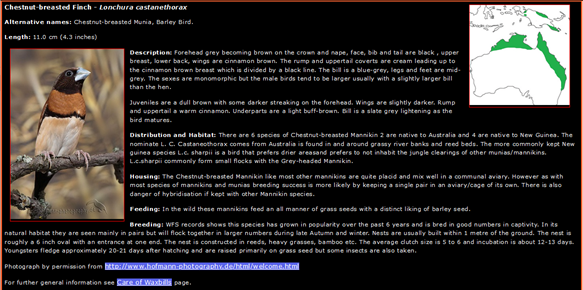
Description of individual species profiles
Page last updated: 06 June 2024
Species Profiles
This section has been updated to include the returns for birds bred in the 2023 calendar year.
The profiles in the expandable links below are some of the species which fall within the scope of the Waxbill Finch Society. The species are listed in line with their breeding returns over the last five, calendar years (2019-2023) - both to reflect the importance of these returns and also to highlight which species are viable/ becoming unviable in UK aviculture.
As an alternative, this link provides the information in plain format on a single page.
Web browser note: we would urge anyone using Internet Explorer to upgrade to Microsoft Edge in order to view these pages in the way they've been designed.
Profiles of the top 10 most-bred species by WFS members in the last five years (2019-2023)
-
661 - African Silverbill (Lonchura cantans)
-

African Silverbill - Euodice cantans
Alternative names: Warbling Silverbill, Black-rumped Silverbill
Length: 10-11 cm (4-4.5 inches).
Description: Pale sandy brown with darker speckling to the head and barring to the body. Wing primaries, rump and tail feathers are black. Underparts paler, starting as pale buffish brown on chest and fading to off-white on the belly and under-tail coverts. Bill is silver-blue, sometimes with darker upper mandible.
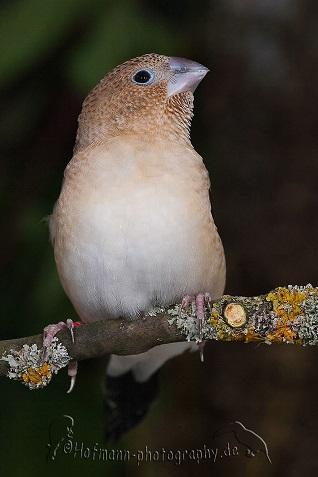
Female is much the same as the male, though the colouration of the black feathering may be less intense. The central tail feathers are said to be broader and more rounded at the tip in the female than in the male. Juvenile is similar to the adult, but with browner tint above and less distinct barring and speckling.
Distribution and Habitat: Favours dry habitat such as savannah or sparse scrubland, but is also found in cultivated areas. Usually found in flocks and generally feeds on the ground, taking mainly grass seeds.
Housing: Fits in well in a mixed aviary, though caution needs to be exercised due to a high inclination to hybridise. Gray (1958) lists species running from many of the Mannikins through to the Common and Black-rumped Waxbills as being known to have cross-bred with African Silverbills. Conversely, breeding success is likely to be impaired if kept in the company of more assertive species.
Feeding: These birds are almost entirely seed-eating, even when feeding young. Most observers suggest that live food is seldom, if ever, taken. Sprouted seed may, however, be appreciated and it has been reported (Immelman) that egg food will be utilised during breeding.
Breeding: The African SIlverbill is regularly bred in captivity and is often used for fostering purposes in the manner of the Bengalese. Will nest in standard boxes and baskets or build in vegetation, also has a propensity for the utilisation of old nests such as those of weavers. An average of five eggs are laid, incubation is around 11 days and the young fledge at around 21 days.
References: Avon, Tilford and Woodham (1982); Goodwin (1982); Restall (1996).
Photograph by permission from http://www.hofmann-photography.de/html/welcome.html
For further general information see Care of Waxbills page.
-
-
456 - Chestnut-breasted Finch (Lonchura castaneothorax)
-
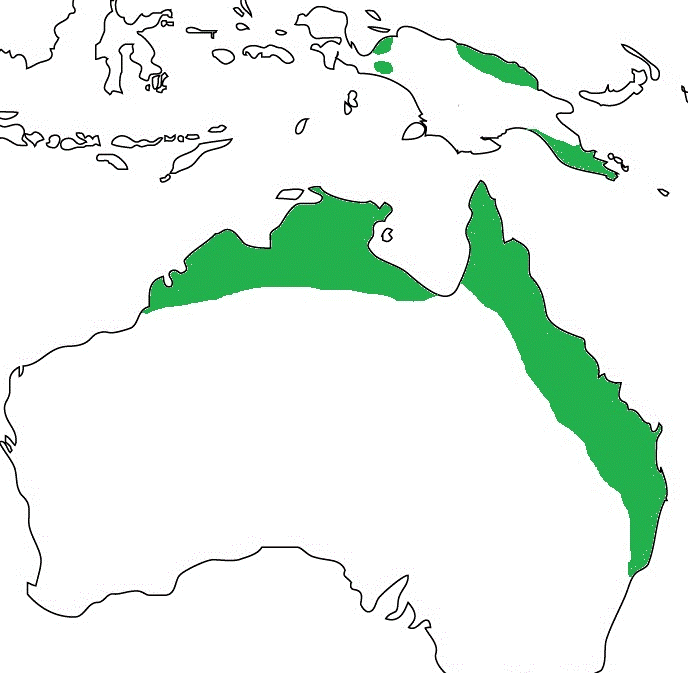
Chestnut-breasted Finch - Lonchura castanethorax
Alternative names: Chestnut-breasted Munia, Barley Bird.
Length: 11.0 cm (4.3 inches)
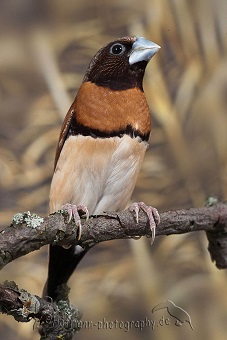
Description: Forehead grey becoming brown on the crown and nape, face, bib and tail are black , upper breast, lower back, wings are cinnamon brown. The rump and uppertail coverts are cream leading up to the cinnamon brown breast which is divided by a black line. The bill is a blue-grey, legs and feet are mid-grey. The sexes are monomorphic but the male birds tend to be larger usually with a slightly larger bill than the hen.
Juveniles are a dull brown with some darker streaking on the forehead. Wings are slightly darker. Rump and uppertail a warm cinnamon. Underparts are a light buff-brown. Bill is a slate grey lightening as the bird matures.
Distribution and Habitat: There are 6 species of Chestnut-breasted Mannikin 2 are native to Australia and 4 are native to New Guinea. The nominate L. C. Castaneothorax comes from Australia is found in and around grassy river banks and reed beds. The more commonly kept New guinea species L.c. sharpii is a bird that prefers drier areasand prefers to not inhabit the jungle clearings of other munias/mannikins. L.c.sharpii commonly form small flocks with the Grey-headed Mannikin.
Housing: The Chestnut-breasted Mannikin like most other mannikins are quite placid and mix well in a communal aviary. However as with most species of mannikins and munias breeding success is more likely by keeping a single pair in an aviary/cage of its own. There is also danger of hybridisation if kept with other Mannikin species.
Feeding: In the wild these mannikins feed an all manner of grass seeds with a distinct liking of barley seed.
Breeding: WFS records shows this species has grown in popularity over the past 6 years and is bred in good numbers in captivity. In its natural habitat they are seen mainly in pairs but will flock together in larger numbers during late Autumn and winter. Nests are usually built within 1 metre of the ground. The nest is roughly a 6 inch oval with an entrance at one end. The nest is constructed in reeds, heavy grasses, bamboo etc. The average clutch size is 5 to 6 and incubation is about 12-13 days. Youngsters fledge approximately 20-21 days after hatching and are raised primarily on grass seed but some insects are also taken.
Photograph by permission from http://www.hofmann-photography.de/html/welcome.html
For further general information see Care of Waxbills page.
-
-
430 - Black & White Mannikin (Lonchura Bicolor)
-
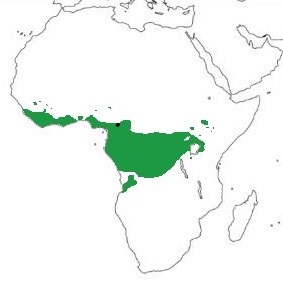
Black & White Mannikin - Lonchura bicolor
Alternative names: Black & White Munia
Length: 10.0 cm (4 inches).
Description: Head, chest Back, wings and rump are a shiny black with a slight hint of green. The flanks are black with broad white strips. Under wing, lower breast to under tail coverts are white. Beak is silver-blue to grey. Legs are black. The sexes are monomorphic. Juveniles are a dull brown-grey where the black is on the adults.
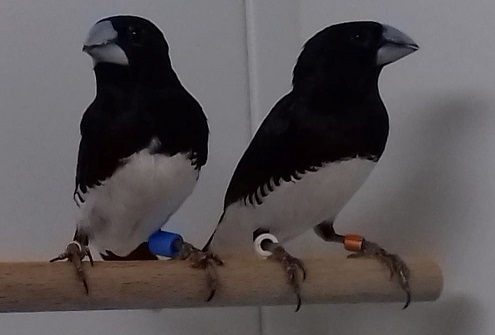
Distribution and Habitat: Native to Guinea, Southern Mali Ghana, Togo Nigeria and coastal Cameroon. Usually found in small groups of around 12 birds in grassland, savanna with bushes, forest edges and clearings. Often near wetlands.
Housing: The Black & White Mannikin are often seen with Bronze-winged Mannikins and common waxbills. Generally a sociable bird given space as they can be a dominant bird in the aviary. As with most munia there is a danger of hybridisation if kept with other closely related Lonchura.
Feeding: In the wild these mannikins feed almost entirely on seed and are more insectivorous than Bronze-winged Mannikins. It is good to offer green millet or soaked seed for conditioning and rearing chicks soaked seed usually mixed with eggfood.
Breeding: WFS records show that although over the years this species has been bred it has only in recent years, since 2015, been bred consistently. As the recent availability of the species has increased more have taken it upon themselves to breed this small Lonchura species. They breed well in a planted aviary but are more productive in cages. They accept a typical half-open nestbox making a neat sphere of coco fibre nest inside. Typically 3 to 7 eggs are laid with a 13 day incubation period, more often than not they parent rear. Fledging around the 20 day old mark.
Photograph by permission of Adrian Walls.
For further general information see Care of Waxbills page.
-
-
345 - Java Sparrow (Lonchura Oryzivora)
-
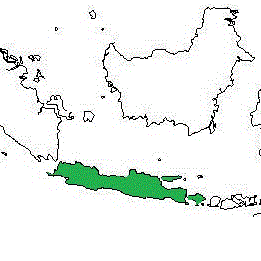
Java Sparrow - Lonchura Oryzivora
Alternative names: Java Finch, Rice Bird, Paddy Bird
Length: 13.5cm (5.3 inches).
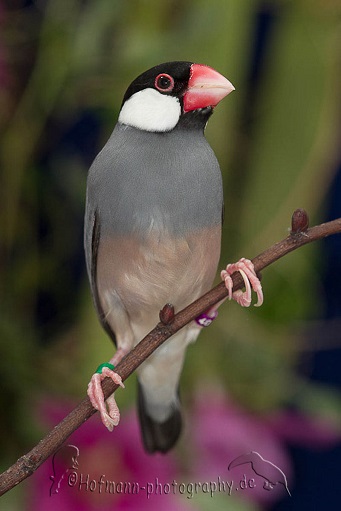
Description: Male: From the forehead over the top of the head and a thin line around the beak and chin are black circling the white cheek patches. Nape to lower back, wings and breast is a bluish grey. Back and wings a warmer grey. Flanks are a light flesh colour. Vent and undertail are white. Bill, skin around the eyes legs and feet are pink.
Female: The difference between the sexes can’t be distinguished through plumage. But when in breeding condition the eyelids and base of the beak are less swollen.
Distribution and Habitat: : The Java Sparrow is found in Java and adjacent islands of Bali and Kangean. Found in cultivated grassland with preference to cereal crops especially rice. There are no known sub-species of Java Sparrows but in captivity there are a growing number of mutations from fawn to silver and white.
Housing: The Java sparrow is often found in small flocks and is often found in mixed flocks with Red Avadavats and sometimes other Lonchura.
Feeding: In the wild when the rice is ripening they gather in large flocks to feed, they also feed on seeding grasses.
Breeding: WFS records suggest that this bird has been bred in captivity consistently in reasonably good numbers since 1998.
The Java Sparrows prefer larger nest boxes to wicker baskets. Various grasses, coco fibre and hay being preferred nesting materials. Clutch size varies from 2 to 9 and incubation is about 13 days. Youngsters fledge approximately 21 days later.
Photograph by permission from http://www.hofmann-photography.de/html/welcome.html
For further general information see Care of Waxbills page.
-
-
328 - Violet-eared Waxbill (Uraeginthus granatina)
-
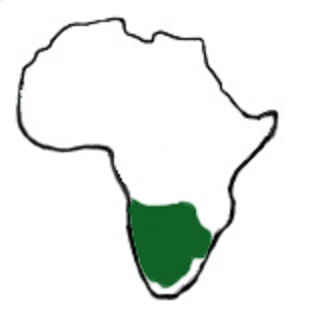
Violet-eared Waxbill - Uraeginthus granatina
Alternative names: Grenadier Waxbill, Common Grenadier
Length: 14-15cm, 5.5-6 inches.
Description: Band of deep blue between tops of eyes and base of bill, which is red in mature adults. Purple cheeks; chin and throat are black, rest of head is deep brown, and this colour extends down mantle and back. The underparts are this same shade of brown. Black tail, with deep blue edges.Wings are a lighter shade of brown and edges of component feathers are lighter still.
Females are a lighter shade ofthe same basic colouration, and have a somewhat shorter tail. Juvenile colouration resembles the adult female but is duller and has much less obvious cheek patch, the bill is black.Undergoes partial moult at 25-35 days, shedding the feathers only of those parts of the head that are purple, blue or black in the adult, the complete moult to adult plumage takes place several weeks later.
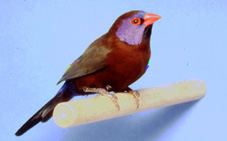
Distribution and Habitat: Widely distributed over most of southern Africa. Frequents dry scrub, open woodland with a thorn understorey, and sometimes scrub vegetation along the banks of streams. The Violet-eared Waxbill often occupies territory a long way from water, in this situation it is thought that they may feed on termites as an alternative source of moisture.
Housing: Not one of the hardier waxbills in the UK climate. Should ideally be kept inside during the colder months, but if remaining in aviary accommodation must be given a heated shelter. Goodwin states that these birds will not tolerate others of their own or even closely-related species in close proximity and should therefore be kept one pair to an aviary.
Feeding: Should have a good foreign finch mix, with extras such as wild seeds and seeding grasses in season. These birds are more insectivorous than most waxbills and will benefit from live food, and/or a specialist softbill-type mixture, all the year round.
Breeding: The rounded nest is built of grass stems or similar, and lined with feathers. It has a side entrance which may feature a rudimentary porch. A clutch is 2-5 eggs, and incubation is around 13 days, with hatched young remaining in the nest for up to three weeks. Youngsters will not be reared successfully without plentiful live food. Breeding in an outdoors aviary is often unsuccessful in the British climate, the parents will sleep out of the nest after the first week and the chicks may suffer in a cold snap.
References: Clement, Harris and Davis (1999); Goodwin (1982); Restall (1975); Verhoef-Verhallen (1999).
Now available: WFS keeping and breeding booklet for this species.
-
-
316 - Peter’s Twinspot (Hypargos niveoguttatus)
-
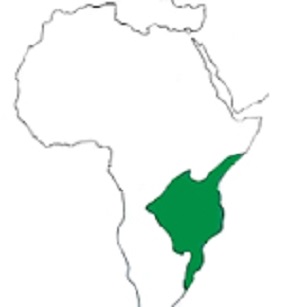
Peter’s Twinspot - Hypargos niveoguttatus
Alternative names: None listed
Length: 3.75 to 4.5in (9.5 to 11.5cm).
Description: Male - Forehead to crown deep grey, mantle and back reddish brown. Face, breast and neck deep crimson. Underparts black, boldly spotted with white on sides. Bill greyish blue and legs are slate grey.
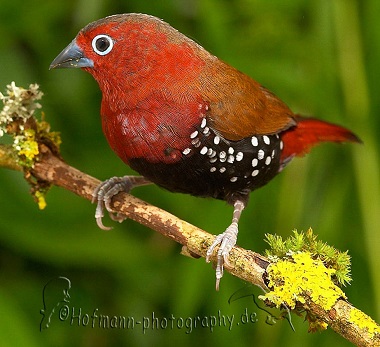
Female is paler with buffish grey on the head. Throat and breast buff.
Distribution and Habitat: Malawi, Zimbabwe, Mozambique, Zaire, Kenya and Tanzania.
Inhabits lowland bush or grassland, evergreen thickets, acacia scrub at edges of secondary forest near streams. Occasionally close to human habitation.
Feeding: Feeds on a variety of seeds and occasionally small insects. In captivity readily takes panicum and other millets, canary seed and half ripe grass seeds. Probably needs live food to rear young.
Breeding: Often prefers to nest on the ground among cover. Incubation period 12-13 days (sometimes longer) and young fledge at about 21 days. It has been reported that in the wild they may indulge in a communal display with males hopping round displaying to each other and the hens watching.
In captivity, pairs in breeding condition are often aggressive not only towards conspecifics but also towards related or similarly coloured species.
Photograph by permission from http://www.hofmann-photography.de/html/welcome.html
For further general information see Care of Waxbills page.
-
-
292 - Bronze-winged Mannikin (Lonchura cucullata)
-
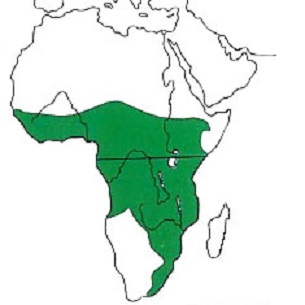
Bronze-winged Mannikin - Lonchura cucullata
Alternative names: Bronze-winged Munia
Length: 3.5 to 4in (9 to 10cm).
Description: Sexes alike. Entirely black head to chin, throat and centre of breast. Mantle, back and wings dark brown. Mantle, back and wings dark brown, tinged greyish. Scapulars glossed with green. Rump and upper-tail coverts barred black and white. Has white underparts except for smudges of black on sides of breast, becoming black crescents on flanks.
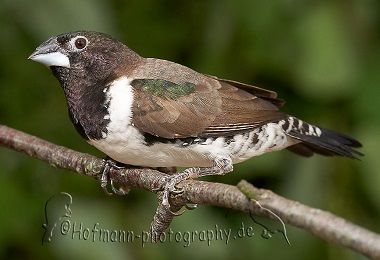
Distribution and Habitat: Senegal and Gambia to Sierra Leone and east to Guinea, southern Mali, Ghana, Nigeria, Cameroon, Central African Republic to Uganda, south and south-west Sudan and west Kenya, south through Gabon, Congo to north-west Angola. In the wild inhabits open country, scrub and cultivated areas.
Has been introduced into Puerto Rico.
Housing: In captivity has been bred in cages and aviaries. Highly gregarious and can be kept in a colony, but can sometimes be aggresive to other species. Usually roosts in nests which may be built specially for this purpose and frequently dismantled and rebuilt. Fairly hardy but temperature should not be below 10 degrees C. Fairly tame only taking alarm at the last moment.
Feeding: Various millets and grass seeds. May take small quantities of insects. When feeding young prefers half ripe grass seeds and hard seeds are often ignored. Egg food and insect food may be taken.
Breeding: May use baskets and boxes or sometimes build their own nest. Incubation period usually about 12 days and young fledge at 18-21 days old.
Photograph by permission from http://www.hofmann-photography.de/html/welcome.html
Now available: WFS keeping and breeding booklet for this species.
-
-
266 - Purple Grenadier (Granatina ianthinogaster)
-
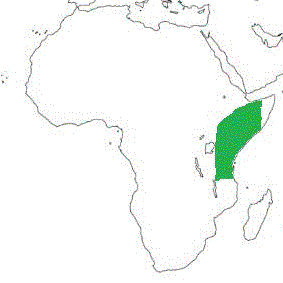
Purple Grenadier - Granatina ianthinogaster
Alternative names: Purple Waxbill
Length: 14.0 cm (5½ inches).
Description: Male: Forehead to crown, upper mantle, throat upper breast deep russet brown. Upper lores to over eye, cheeks and ear coverts deep blue. lower mantle, back dark brown with russet brown edges. Rump and upper tail deep violet blue. Bill red/ deep pink-red. Eyes are red, orbital ring also red. Legs/feet dark grey-black.
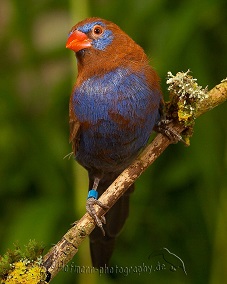
Female: Forehead to crown warm brown. Becoming warmer brown on mantle, back and wing. Rump and upper tail coverts deep violet blue Face generally duller than male with a pale blue ring around the eyes. Rest of head, neck light buff brown. Bill same as male but slightly paler. Eyes red with orange orbital ring. Legs as male.
Juvenile: General similar to female with no blue around the eyes. Generally a light buff brown colour.
Distribution and Habitat: There are 3 subspecies of Purple Grenadier all come from East African central and southern Kenya to northern central Tanzania. South east Sudan and southern Ethiopia, Somalia, Northern Kenya and Northern Uganda. Highlands of central Kenya. Usually found in dense thornbrush, scrub and dry brush. Quite often low in bushes and grasses. Occur in the wild on there own or in pairs or very small flocks.
Housing: The Purple Grenadier can be a very violent species towards its own kind and are recommended for experienced breeders only. Time must be taken when introducing a pair together for the first time. Usually a double breeder with a wire divider between the birds and a perch once the pair look comfortable with one another the divider can be removed but it is important to check that all is ok for the first few weeks and not hesitate to put the wire divider back in place
Feeding: : In the wild these Estrildids feed an all manner of grass seeds, small seeds and insects (termites, ants)
Breeding: WFS records shows this species in recent years have grown in popularity and is being bred in reasonable numbers in captivity. The average clutch size is 4 to 6 and incubation is about 12-13 days. Youngsters fledge approximately 18 days after hatching and are raised primarily on insects, seeding grasses are also taken. The Purple Grenadier is also breeding host to the Straw-tailed Whydah.
Photograph by permission from http://www.hofmann-photography.de/html/welcome.html
For further general information see Care of Waxbills page.
-
-
256 - Pearl-headed Silverbill (Lonchura Griseicapilla)
-
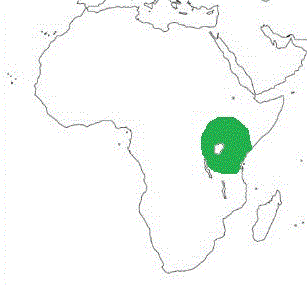
Pearl-headed Silverbill - Lonchura Griseicapilla
Alternative names: Grey-headed Silverbill
Length: 11.5cm (4.5 inches).
Description: Male & female alike: Entire head blueish grey with pale grey to white spots. Back, mantle and underparts are brown lighter towards the vent. Wings and tail dark brown to black. Rump fades quickly from light brown to white. Upper mandible is dark grey, lower silver grey. Legs and feet are dark grey.
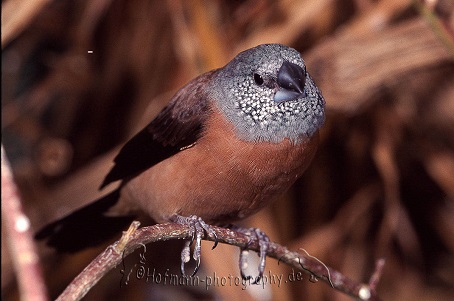
Juvenile: Generally paler and more buff than the adults also lacking white/ grey spots on the head. Youngsters cannot be confused with any other juvenile Lonchura.
Distribution and Habitat: The Pearl-headed Silverbills native to East Africa from South Ethiopia , South-eastern Sudan to the East and through Kenya, Burundi to Northern Tanzania. They live in small flocks commonly found with African Silverbills. Live mainly in savannah, arid grassland and open thorny scrub country not far from water.
Housing: The Pearl-headed Silverbill is not an aggressive species if kept in a mixed aviary. Breeding success in captivity can be difficult as pair bonding usually takes place when juveniles are kept together.
Feeding: In the wild these mannikins feed almost entirely on seeding grasses direct from the seed head.
Breeding: WFS records suggest that in recent years this species popularity has increased showing consistent breeding in good numbers in captivity.
In the wild Pearl-headed Silverbills tend to build their spherical nests in trees constructed of grasses and similar materials. Average clutch size is 3 to 6 and incubation is about 14 days. Newly hatched young are pink in colour. Youngsters fledge approximately 24 days later.
Photograph by permission from http://www.hofmann-photography.de/html/welcome.html
For further general information see Care of Waxbills page.
-
-
248 - Red-cheeked Cordon Bleu (Uraeginthus bengalus)
-
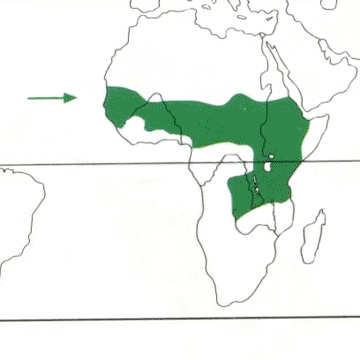
Red-cheeked Cordon Bleu - Uraeginthus bengalus
Alternative names: Cordon bleu (this is more correctly used for the Blue-breasted Waxbill), and Red-cheeked Blue Waxbill
Length 12.5-13 cm (5 inches)
Cock: Face, throat, breast and flanks light bright blue. Rump and upper tail coverts a slightly duller blue. A large patch of dark crimson on the cheeks involving most of the ear coverts. Central tail feathers a dark greenish or greyish blue. Top of the head and the rest of the upper parts a slightly reddish dark brown. Centre of lower breast and under tail coverts pinkish buff. Bill pink or reddish with a black tip. Legs and feet pale brown.
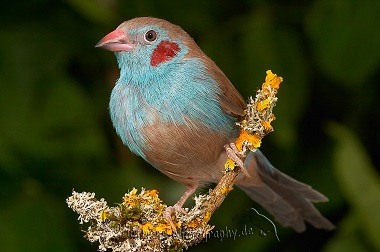
Hen: A little paler than the cock with no red cheek.
Distribution and Habitat: From Senegal and Guinea east to Eritrea and south to coastal and western Tanzania and northern Zambia.
Inhabits thorn scrub, savanna, dry woodland, cultivated areas with bushes or shrubs, gardens, villages and roadsides. Often in very arid country but only if surface water is available.
Feeds: mostly on the ground. Known to take seeds of grasses, termites and other small insects. In captivity feeds largely on small pannicum millet but will also take white millet and small canary seed. Will eagerly take any small live food such as mini mealworms or buffalo worms Will also take bloodworm (Mosquito larvae) if offered in water. Quite large quantities of live food will be taken when feeding young.
Breeding: In the wild, nests often in thorn bushes. Nest is roundish, quite small with a side entrance and built of grass stems. In captivity will use wicker baskets lined with grass or coconut fibre and some feathers. The clutch is usually three to six eggs and incubation usually starts with the third egg. Sexes take turns with incubation which lasts around 11 days and young fledge at 17 to 19 days.
Courtship display: The cock bird will hold a piece of grass in the beak and bob up and down. As he rises he throws his head backwards. The head feathers are often raised to give the head a triangular appearance.
Photograph by permission from http://www.hofmann-photography.de/html/welcome.html
Now available: WFS keeping and breeding booklet for this species.
-
Profiles of the top 11-20 most-bred species by WFS members in the last five years (2019-2023)
-
242 - Blue-capped Waxbill (Uraeginthus cyanocephalus)
-

Blue-capped Waxbill - Uraeginthus cyanocephalus
Alternative names: Blue-headed Waxbill, Blue-capped Cordon Bleu, Blue-headed Cordon Bleu
Length: 13.0 cm (5 inches).
Description: Male has head, breast and flanks all blue, with brown mantle, back and wings. Bright red bill. Underparts are buff, fading to white at the vent. Female is similar but with brown forehead and crown, and blue parts are paler. Juveniles resemble the female, but with less extensive blue, adult plumage is gained at about 5 months.
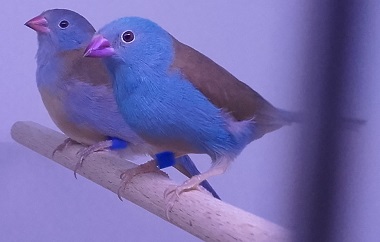
Distribution and Habitat: Occurs in dry bush and scrub country of East Africa, locally abundant but rather less common than the Red-cheeked Cordon Blue. Feeds on the ground, mainly on seeds but also takes some insects such as ants and termites.
Housing: Does well in a mixed aviary, but can be aggressive towards similarly-coloured birds in the breeding season. Sensitive to the cold and should therefore be given sheltered and heated accommodation.
Feeding: A standard waxbill seed mixture, with additional wild/weed seeds as basic diet. Supplement this with seeding grasses whenever possible and live food when raising young. Goodwin states that this waxbill is particularly fond of white and panicum millets, and tends to swallow a proportion of this without shelling it.
Breeding: The Blue-capped Waxbill is among the most regularly bred in aviculture and will reliably bring up its young, given a supply of small livefood when feeding them. Will nest in standard boxes or build in vegetation, ivy for example, using grasses, coconut fibre, etc, and often lines the nest with feathers. Four to six eggs are incubated for around 11 days and fledging takes place when chicks are around 18 days.
References: Goodwin (1982); Clement, Harris and Davis (1999); Restall (1975), Williams and Arlott (1989).
Now available: WFS keeping and breeding booklet for this species.
-
-
220 - Gold-breasted Waxbill (Amandava subflava)
-
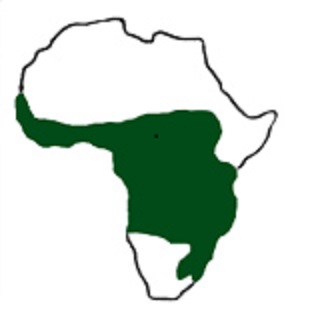
Gold-breasted Waxbill - Amandava subflava
Alternative names: Golden-breasted Waxbill and Zebra Waxbill
Length 9 cm (3.5 in)
Description A tiny bird with a shortish tail and red upper tail coverts, throat and breast olive grey, dark yellow underneath, sides grey with fine yellow wavy lines, the female has pale yellowish underparts and lacks the red eyebrow stripe of cock. Young birds have yellowish-grey plumage and dark markings on their beaks at the time of fledging fledging. The larger and more colourful Clarke’s Waxbill (A.s.clarkei) has a bright yellow abdomen with no orange tinge and comes from southern Africa. Clarke’s is very rare in the UK.
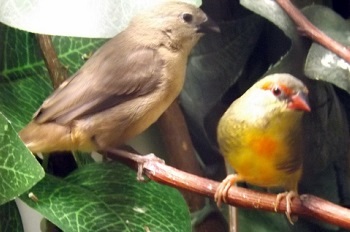
Distribution and Habitat Widespread across Africa, south of the Sahara desert. The Gold-breasted Waxbill is usually found in flocks and roosts communally. It is often found in tall grasslands or savannas, usually near water, perhaps the edges of swamps or marshes, but also feeds in drier areas including cultivation. It feeds mainly on the ground or from the stems of long grasses, with insects also being eaten.
Housing Goldbreasts are excellent avicultural subjects and when well catered for are quite long lived. It is a delightful bird to keep, but rather delicate in response to cold, damp weather conditions. They can be housed with other waxbills and finches provided these are not aggressive and can be kept in small colonies of their own kind. They may display stronger territorial instincts when breeding but serious disputes are unlikely. Careful acclimatisation is essential and you should not rush imported Gold-breasted Waxbills into an outside flight until the risk of cold weather has passed - they should not be expected to over-winter without additional heating and lighting.
Breeding They can be induced to breed in a suitable Finch breeding cage or indoor aviary where they may breed two or three times in succession. The cock displays to the hen by hopping around her on the ground, showing a triangular head posture and angled tail. In their natural surroundings they readily adopt old nests of weavers or similar species and reline or renovate them to their liking. This encourages the species to adopt the aviculturist’s choice of nesting receptacle and you will find this waxbill is keen to breed in both half open-fronted wooden nest boxes and wicker nesting baskets. These should have a small amount of soft grass placed in them which pairs will add to and sometimes line with a few feathers. Nests are built not just for breeding as Goldbreasts also like to roost in them.
Some Goldbreasts can be very proficient parents and extremely good sitters and yet others can be completely disinterested in their offspring without any apparent reason. The four to six eggs are incubated by both parents alternately and hatch in twelve days. On hatching the young are at first fleshy-pink with tufts of white down, but after a few days they become dark brown.Both parents take turns incubating and brooding. The young may remain in the nest for more than three weeks and even after fledging will return to the nest at night for some time longer.
The young are yellow-grey when they leave the nest, with yellow-red tail feathers and black bills. These fledglings are similar to young Red Avadavats (a.amandava) with whom there is a close relationship.
Feeding The Golden-breasted Waxbill will thrive on a diet based on a Foreign Finch seed mixture with a little live food (eg mini mealworms) and some commercially available egg food, with greenfood provided when available (such as natural seeding wild grasses and chickweed). They are very accommodating birds and are eager to breed, seeming to prefer to breed in a cage. They are very easy to feed and house and they do not require high temperatures once established, a bird-room temperature of around 10 degrees C in the winter will suffice.
Originally produced for and published in “The Estrildian”
Reprinted here by kind permission of Howard Robinson and “The Estrildid Forum”Now available: WFS keeping and breeding booklet for this species.
-
-
218 - Dybowski’s Twinspot (Euchistospiza dybowskii)
-
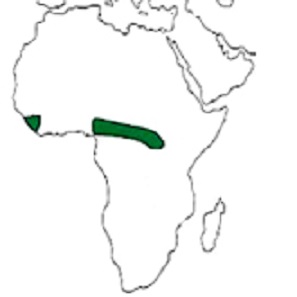
Dybowski’s Twinspot - Euchistospiza dybowskii
Alternative names: Dusky Twinspot
Length: 4.75in (12cm).
Description: Male has entire head, nape, chin and breast slate-grey. Mantle, back and upper tail are crimson. Lower breast is dark slate-grey and flanks and under tail black with bold white spots on flanks. Bill is black, eyes are red with a pale blue eye ring.
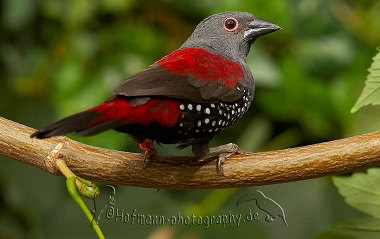
Female is slightly smaller than the male and is paler grey on the head and breast. Red of mantle is duller. Eyes are reddish brown with pale grey eye ring. Wings are blackish brown.
Juveniles are similar to female but lack white spots. Adult plumage is attained within three months.
Distribution and Habitat: Sierra Leone, Guinea, Nigeria, Cameroon, Central African Republic, Zaire and Southern Sudan.
Found in grassy savanna, in grass clumps near rivers, along the edges of forest and sometimes in cultivated areas.
Feeding: Feeds on the ground, mainly on grass seeds but also small insects sometimes by digging in soft ground.
Breeding: In captivity will often nest on the ground, building their own nest on a heap of materials. The nest is built with grass fibres or similar material on a base of coarser material and lined with feathers. Usually 4 - 6 eggs. Both sexes incubate and brood and young are brooded for anything from 7 to 14 days.
They are territorial and adult males will fight each other and attack juveniles as soon as they show adult plumage.
Photograph by permission from http://www.hofmann-photography.de/html/welcome.html
For further general information see Care of Waxbills page.
-
-
204 - Cut-throat Finch (Amadina fasciata)
-

Cut-throat Finch - Amadina fasciata
Alternative names: Ribbon Finch
Length: 12 to 13cm, 4.5 to 5 inches.
Description: Forehead, crown and nape are pale sandy brown with a hint of pink, most feathers showing black bars towards their tip, the back is similarly coloured, but with the barring becoming more v-shaped. The face and throat are creamy white, with a broad band of red across the lower throat and extending up the side of the face, behind the eyes. This band is, of course, what gives the bird its common name. The breast is creamy white, shading to fawn lower down and on the underparts. There is a chestnut patch on the belly.
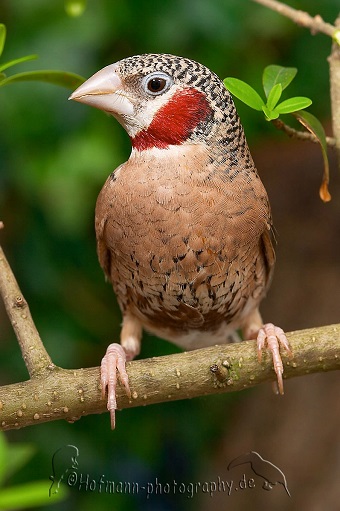
The female is similar to the male, but without the red band or (in most cases) the chestnut on the belly. Juveniles are paler versions of the adult, including the red band on the male.
Distribution and Habitat: Inhabits the drier areas of Africa but is a frequent visitor to water. Favoured habitats are thorn scrub, open woodland, savannah and often cultivated areas in the proximity of villages. Will usually be seen in flocks rather than individually.
Housing: Cut-throats are known to be aggressive to other birds (even larger ones), especially in the breeding season. They will spoil the nests of other birds if kept in a mixed community, and often throw out the eggs and young. Restall states that females seem to succumb to the vagaries of the UK weather earlier and more frequently than males, and for this reason one is likely to see more males than females in aviculture. This would seem sufficient reason for playing it safe and providing good sheltered accommodation all-year round, particularly to newly-acquired birds.
Feeding: In the wild the Cut-throat feeds mainly on grass and millet seeds, with some insects - especially termites. As with most species covered by the WFS, live food is appreciated when feeding its young, although it is said to be one of the few among our species that will raise fledglings successfully on seed and eggfood. Feeding could therefore consist of the usual foreign finch seed mixture with other seeds added for variety, and certainly seeding grasses and other weeds/wild plants will be gladly accepted.
Breeding: Very undemanding in choice of nest site and will often use an old nest or, as mentioned earlier, one that it has emptied of its rightful occupants. The nest will usually be lined with feathers and if constructed from new consists of grasses and similar material. 4 to 6 eggs are laid and incubation is 12 to 14 days, fledging takes place at around 21 days.
References: Clement, Harris and Davis (1999); Goodwin (1982); Restall (1975).
Photograph by permission from http://www.hofmann-photography.de/html/welcome.html
Now available: WFS keeping and breeding booklet for this species.
-
-
190 - White-headed Nun (Lonchura maja)
-
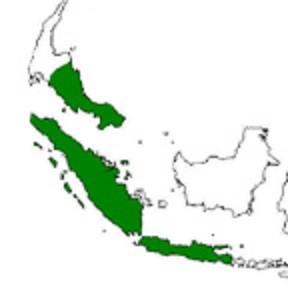
White-headed Nun - Lonchura maja
Alternative names: White-headed Munia, White-headed Mannikin, Maja Mannikin
Length: 4.5in (11.5cm).
Description: The head is white, upper breast, back and wings are reddish brown. The eyes are brown, the beak is a silver blue and the legs are dark grey. It is difficult to distinguish between the sexes. The male’s head is sometimes a brighter white usually after the second moult, also the male’s beak is larger than the females. Juvenile’s back and wings are a lighter brown and the breast and under parts are a beige shade.
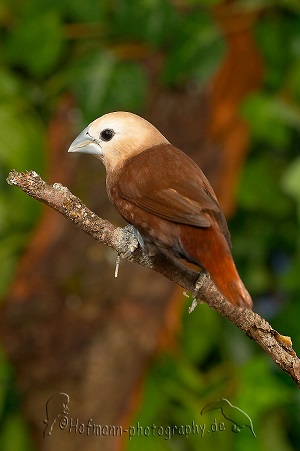
Distribution and Habitat: The White-headed Nun originates from southern Thailand, Malay Peninsula and Indonesian Islands. They are found in open grassland and rice fields, sometimes in enormous flocks to feed and roost.
Housing: The White-headed Nun is not aggressive toward other species if kept in a mixed aviary. Breeding success can be achieved by keeping a small flock in an outside aviary dependant on size. There is a danger of hybridisation if kept with other mannikin species.
Feeding: In the wild these mannikins feed almost entirely on seeding grasses direct from the seed head. These birds don’t require live food to raise their young. In captivity they take eggfood sparingly but soaked and sprouting seed is recommended.
Breeding: Until recenlty, WFS records suggest that this bird has not been bred consistently in good numbers in captivity. In its natural habitat, the nest is more round than oval, constructed of blades of grass, bamboo and other large leaves in clumps of grass and bamboo. They also use abandoned weaver nests adapting the entrance to suit.
It is recommended to plant bamboo in an aviary, as this will provide the most natural nest site for this species. Nest baskets of various sizes should be hung at different heights to encourage breeding. White-headed Nuns are quite a shy bird and seldom breed in cages. Best results in cages occur when the cage is situated in a quiet part of the bird room with plenty of cover.
Average clutch size is 3 to 7 and incubation is about 13 days. Youngsters fledge approximately 21 days later.
Photograph by permission from http://www.hofmann-photography.de/html/welcome.html
Now available: WFS keeping and breeding booklet for this species.
-
-
170 - Spice Finch (Lonchura Punctulata)
-
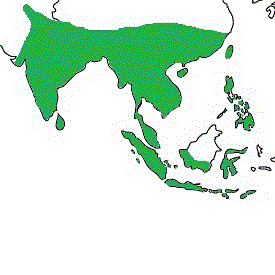
Spice Finch - Lonchura Punctulata
Alternative names: Scaly-breasted Munia, Spice Bird and Nutmeg Finch
Length: 11.0cm (4¼ inches).
Description: Male & Female: Head, throat and upper breast reddish brown. Crown to lower back and wings are an earthy brown. Rump and tail are brown to light brown with the possibility of slight barring. Breast and flanks are white with black edging forming contrasting scaling. Upper mandible black, lower dark grey. Legs and feet are grey.
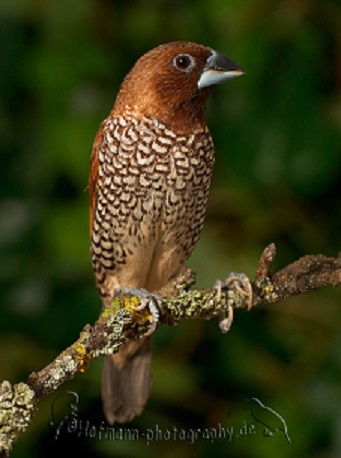
Distribution and Habitat: There are 13 recognised subspecies of the Spice Finch and are by far the most common Munia in Asia from Pakistan, Punjab, India sub-continent to Sri Lanka, Bhutan Bangladesh, Thailand, Java to name a few areas.
Like most other Munias they tend to habit semi open wooded areas with grass clearings. Also adaptable to man-made environments.
Housing: The Spice Finch is a very sociable bird found in small flocks to flocks in the hundreds. As with most Munia also a danger of hybridisation if kept with other Munia species.
Feeding: In the wild these mannikins feed almost entirely on seeding grasses direct from the seed head. Generally these birds don’t require live food to raise their young. In captivity they take egg food sparingly but soaked and sprouting seed is also recommended.
Breeding: WFS records suggest that this bird has been bred fairly consistently in good numbers in captivity.
Spice birds are a colony breeding but are also found in solitary pairs. Nest baskets of various sizes should be hung at different heights to encourage breeding. Average clutch size is 5 to 6 and incubation is about 14 days. Youngsters fledge approximately 19 days later.
Photograph by permission from http://www.hofmann-photography.de/html/welcome.html
Now available: WFS keeping and breeding booklet for this species.
-
-
156 - Moluccan Mannikin (Lonchura molucca)
-
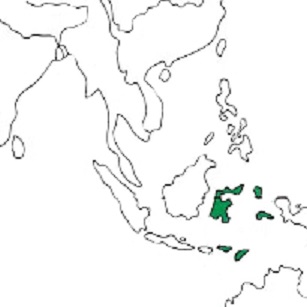
Moluccan Mannikin - Lonchura molucca
Alternative names: Moluccan Munia.
Length: 3.75 to 4.5in (9.5 to 11.5cm).
Description: Sexes alike. Head, breast, upper tail coverts and tail black. Nape, sides of neck, mantle and back medium earth brown. Wing coverts a slightly darker and more reddish brown. Secondaries, primary coverts and primaries blackish brown. Underwing coverts mainly buffish but those along the wing edge white with fine wavy and/or crescent bars or spotted bars of black. Bill with upper mandible leaden grey or bluish grey. Very similar to the White-rumped Munia (Lonchura striata).
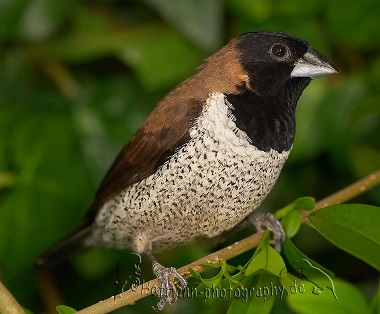
Distribution and Habitat: The Moluccans and nearby islands, the Celebes, the Lesser Sunda islands (excluding Lombok and Bali) and the Kangean islands. In the wild inhabits grassy and bushy areas at forest edges, clearings and cultivated areas. Not wary of humans. Probably feeds largely on grass seeds. Usually in family parties or small groups.
Housing: In captivity this species seems well suited to cage life, seeming to appear to prefer to breed on their own in a cage rather than in an aviary. Temperature should be maintained at above 10 degrees C.
Feeding: A Foreign Finch or Budgie mixture with Japanese millet and millet sprays, seeding grasses and a few mealworms together with the usual grit and cuttlefish bone. When feeding young may take large quantities of soaked seed and some greenfood.
Breeding: These birds have been bred more successfully in cages than in aviaries. Usually 4 to 5 eggs are laid, but up to 7 have been recorded. Incubation period about 15 days, fledging at about 21 days old. Both sexes share incubation.
Photograph by permission from http://www.hofmann-photography.de/html/welcome.html
Now available: WFS keeping and breeding booklet for this species.
-
-
156 - Red-headed Finch (Amadina erythrocephala)
-
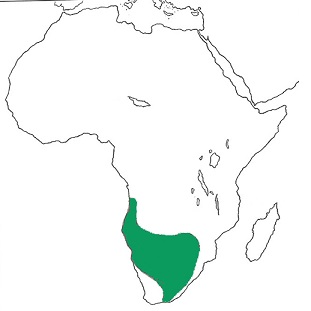
Red-headed Finch - Amadina erythrocephala
Alternative names: None listed
Length: 4.75 to 5 inches (12 to 13cm).
Description:Male has an all red head and face except the lores. Sandy or grey brown upper parts and slightly darker wings with pale buff tips to coverts and edges of tertials. Dark or grey brown tail with white spots on tips of outer feathers.
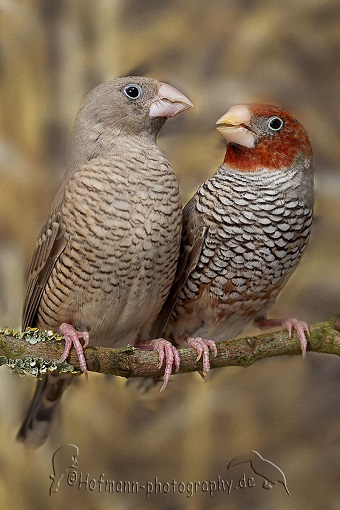
Underparts heavily barred or scaled. Females lack any red on the head and are uniform grey brown or sandy on head, face and upper parts and prominently barred or scaled below.
Distribution and Habitat: Angola, Namibia, Botswana, Zimbabwe, Cape Province, Transvaal and Natal.
In the wild inhabits cultivated areas rice fields, gardens and bushy and grassy areas. Eats grass seeds and cultivated rice. Both ripe and unripe. Usually found in pairs or small parties.
Housing: In captivity this species seems well suited to cage life.
Feeding: A good Foreign Finch mixture with red and panicum millet and egg food. Some insect food may be taken but does not seem to be essential. Cuttlefish bone, crushed eggshell and a mixture of grits should always be available, together with fresh water.
Breeding: In the wild they are highly social and often two or three pairs will prospect for nest sites together and nest close to each other. In captivity they have been found to be less aggressive than the Cut-throat Finch but it would seem unwise to chance keeping them with weaker species that one hopes to breed from or with Cut-throats as there would be a big risk of hybridisation. These birds seem well suited to cage breeding and have been bred in 24” x 12” double breeding cages. Incubation period usually about 12-14 days and young fledge at 20 days old.
Photograph by permission from http://www.hofmann-photography.de/html/welcome.html
Now available: WFS keeping and breeding booklet for this species.
-
-
150 - Red-billed Firefinch (Lagonosticta senegala)
-
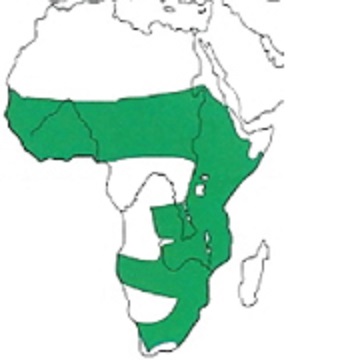
Red-billed Firefinch - Lagonosticta senegala
Alternative names: Common Firefinch, Senegal Firefinch
Length: 4in (9-10cm).
Description: Male : Top of head, mantle and back a slightly reddish light earth brown strongly washed with red, carmine or scarlet. Red is most extensive on forehead and hind neck. Wings brown with a varying amount of red. Rump and all but the outermost tail feathers rose red. Sides of the breast spotted with small white spots to varying degrees. Iris brown and eye rims yellow and conspicuous. Bill red or pink. Female : Buffish brown with red stripe from base of lower mandible to, and sometimes over, the eye. White spots on the breast larger and usually more profuse than on the male. Juvenile : Like the female but with no red on the face and no white spots and an entirely black bill. The mainly red bill distinguishes it from the other firefinches.
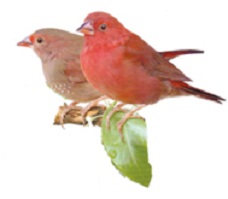
Distribution and Habitat: Tropical and Southern sub-tropical Africa. Widely distributed but absent from some tropical forest and desert areas. In the wild very tame and usually in pairs or small parties. Lives in Acacia woodland or in cultivated areas and villages around human dwellings.
Feeding: Feeds mainly on the ground on grass and other small seeds. Will take small insects but in the wild will rear young almost entirely on green seeds. Dry seed alone is not adequate unless some insect food is also available.
Breeding: Will nest in a variety of sites, in a hole in a building or bank, even on the ground and especially in thatched roofs of huts. Uses feathers, preferably white, to line the nest. Usually only the male builds the nest. Both sexes brood and the incubation period is 11 to 12 days with young fledging at 18 days. They are fed by the parents for a further 8 to 10 days.
Now available: WFS keeping and breeding booklet for this species.
-
-
124 - Red Avadavat (Amandava amandava)
-
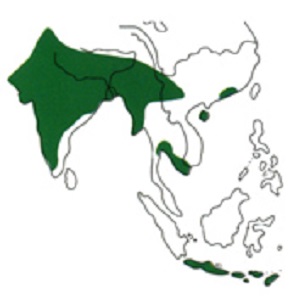
Red Avadavat - Amandava amandava
Alternative names: Tiger Finch, Strawberry Finch (bird dealers often use this name for the race A.a.punicea only), Red Munia
Length: 10cm, 4 inches.
Description: The Red Avadavat is the only Estrildid where the cock has an “eclipse” plumage. Outside the breeding season the cock resembles the hen. In the breeding season the cock is coppery red to deep scarlet. The lores are black and there is a narrow white stripe just below the eye and he has a crimson bill. Wings and tail are dark brown, the ventral regions blackish and the top of his head and back are reddish brown. Lower breast, flanks, wings and rump are dotted with white.
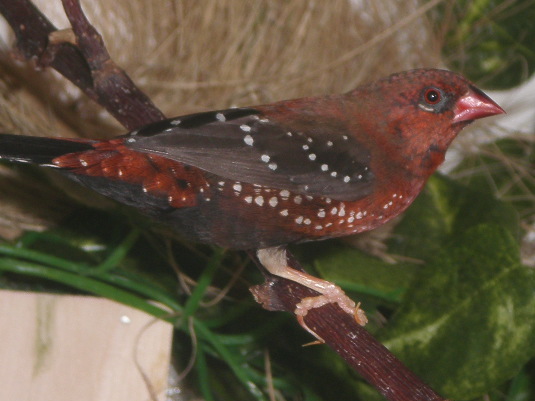
The hen is dark brown, paler beneath and inclining to yellowish or pale gold on the belly with white spots on the wings and a red rump. When there is a lack of natural light the plumage will lose colour. Even in non-breeding colour cocks can be identified as hens are more greenish or dull olive.
Distribution and Habitat: The nominate race Amandava amandava is found in Pakistan, Kasmir, India, S.Nepal, Assam and Bangladesh. The subspecies A.a.punicea is from Indochina, Java and Bali. The subspecies A.a.flavidiventris iinhabits Burma, Yunnan, Lombok, Sumba and Timor.
Inhabits riparian or marshy areas, tall grass, reed beds. Also sugar cane fields, clearings in the jungle or cultivated areas.
Housing: Are reasonably hardy but need to be kept in heated accommodation during the colder months.
Feeding: Feeds mainly on seeds of grasses in the wild, but seem to feed mainly on small yellow millet in captivity. When feeding young, will take live food such as small white-skinned mealworms and fruit fly, soaked seed and egg-food.
Breeding: Nest is built by both cock and hen and is roundish with a side entrance and sometimes a short tubular entrance. Sometimes low down or even on the ground. Usually four to six eggs, incubated by both birds, hatching in 11-12 days and the young fledge in about 20-21 days.
Females will often show aggression to other females if a cock in breeding plumage is present. The courtship display of holding a piece of grass or feather in the bill and bowing can be performed by either sex.
Now available: WFS keeping and breeding booklet for this species.
-
Available profiles of the top 21-30 most-bred species by WFS members in the last five years (2019-2023)
-
92 - Yellow-winged Pytilia (Pytilia hypogrammica)
-

Yellow-winged Pytilia - Pytilia hypogrammica
Alternative names: Golden-winged Pytilia, Red-faced Pytilia, Red-faced Aurora Finch
Length: 12.5-13cm, 5 inches.
Description: Face is red, with top of head medium grey, as is the back. Rump and upper tail coverts red, tail is black. Median and greater coverts yellow (shade is variable) sometimes with tint of green or orange, primary coverts and flight feathers are grey. Underwing coverts barred white and grey. Breast is grey, becoming darker grey with fine white barring lower down, underparts grey with undertail coverts being dark grey with white tips. Bill is black and eyes red.
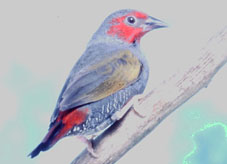
Female does not have the red face and is generally lighter grey, showing brownish tinge. Juveniles are as the female, but somewhat paler with bill less black.
Distribution and Habitat: Western Africa including Sierra Leone, parts of Guinea and Cameroon. Found in open country or savannah, sometimes in lightly-wooded areas.
Housing: Seems to be relatively hardy but should ideally be kept inside during the colder months, or if remaining in aviary accommodation must be given a heated shelter.
Feeding: Basic diet will be a good foreign finch mix, with extras such as wild seeds and seeding grasses in season. Insects are taken throughout the year but are especially important during the breeding season, when a lack will almost certainly result in nest failure. Green food such as chickweed and broccoli heads will often prove attractive.
Breeding: The nest in the wild is usually built in a bush, and consists mainly of grasses. In captivity an open-fronted nest box seems to be the preferred platform. An average clutch is 4 eggs, incubation is carried out alternately by both parents and lasts approximately two weeks, with hatched young remaining in the nest for up to three weeks. As previously mentioned, they are unlikely to be reared successfully without plentiful live food.
References: Clement, Harris and Davis (1999); Goodwin (1982); Verhoef-Verhallen (1999).
Now available: WFS keeping and breeding booklet for this species.
-
-
83 - Orange-cheeked Waxbill (Estrilda melpoda)
-

Orange-cheeked Waxbill - Estrilda melpoda
Alternative names: Red-cheeked Waxbill
Length: 10cm, 4 inches.
Description: Easily identifiable bird by virtue of it’s orange face, which is always present, including at juvenile stage. Grey head, brown back and wings, orange-red rump and black tail. Underparts buff to pale grey. The sexes are difficult to separate, some suggest that brighter/larger orange cheek patches are indicative of a male, but this is thought to be unreliable. Juveniles are paler versions of the adult. There is at least one sub-species of the orange-cheek (Estrilda melpoda tschadensis), which displays generally ruddier appearance.
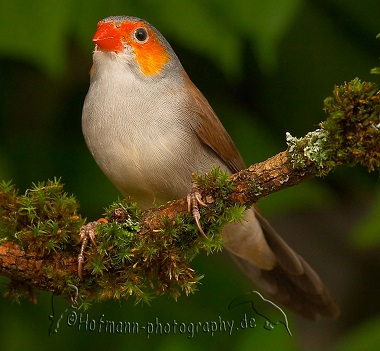
Distribution and Habitat: Western and Central Tropical Africa. Prefers grassland in close proximity to water or grassy clearings in forested areas.
Housing: The Orange-cheeked seems to be one of the hardier waxbills but nevertheless it is unreasonable to expose them to the hardships of a typical UK winter and expect them to thrive. If kept in an aviary a heated shelter is essential, a combination of cold and damp will always have ill consequence. It is also necessary to provide artificial lighting to prolong feeding opportunities during the darker months. It is a particular pleasure of the author to observe the enthusiasm of these birds in the bird bath, though one should stand well back to avoid a soaking! Although Orange-cheeks will live peacefully in groups or alongside other species, if kept in these conditions breeding results will be poor. For optimum breeding success they should be kept one pair to a flight.
Feeding: Should have a variety of small seeds available, for instance a good foreign finch mix, wild seeds, maw, niger and millet sprays. Seeding grasses should be presented when available and small insects are taken keenly. Most Orange-cheeks seem to appreciate soaked seed and will tackle broccoli florets. During their time in the nest livefood forms a significant proportion of the diet of young birds.
Breeding: The nest in the wild is pear-shaped and constructed of grass stems, often on, or close to, the ground. A ‘cock’s nest’ is often added. Orange-cheeks will build in suitable vegetation in a planted aviary, or they may use nestboxes or baskets where available. Artificial nest sites should be shielded by vegetation, for instance conifer prunings, to offer privacy to their occupants who are highly likely to abandon a disturbed nest. A clutch consists of 4-6 white eggs, incubation is 12-13 days and hatched young will remain in the nest for up to three weeks. The young will become independent after about a further two weeks.
References: Clement, Harris and Davis (1999); Serle, Morel and Hartwig (1988); Verhoef-Verhallen (1999); Goodwin (1982).
Photograph by permission from http://www.hofmann-photography.de/html/welcome.html
Now available: WFS keeping and breeding booklet for this species.
-
-
80 - St Helena Waxbill (Estrilda astrild)
-

St Helena Waxbill - Estrilda astrild
Alternative names: Common Waxbill
Length 12-13cm, 4.5-5 inches.
Description: Bright red bill, red eye stripe narrowing from front to back to taper off at the rear of the ear coverts, head is greyish. Upper parts are light to medium brown, under parts paler with pink tinge to lower breast and belly. Fine but obvious striping to whole body is a feature which differentiates E. astrild from E. troglodytes, the Red-eared Waxbill. Dark brown tail which can appear comparatively long and is often flicked from side to side.
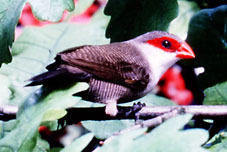
The sexes are difficult to separate, some feel that the male tends to display more vivid pink underparts in breeding condition, and that the striping on females is less distinct. Juveniles are paler in all respects with narrower eye stripe and a black beak. There are many geographical races of this species with subtle differences in plumage.
Distribution and Habitat: Widely believed to be the commonest and most widespread of the African waxbills, and found throughout most of Africa south of the Sahara. Has also been introduced onto surrounding islands and further afield to Portugal, Spain and also South America. Nests in loose colonies in long grass and is typically (but not exclusively) found in grassland, such as the savannah. Also frequently found close to water.
Housing: The St Helena is among the more hardy of the waxbills but nevertheless the normal guidelines apply, and they should not be made to suffer the hardships of exposure to the UK winter. When kept in an aviary a heated shelter is essential, a damp atmosphere must be avoided at all costs. It is important to provide artificial lighting to prolong feeding opportunities during the darker months. In the author’s experience these birds are not aggressive to other species in a mixed collection but, as always, care should be taken when introducing new birds to an established group.
Feeding: Should have a variety of small seeds available, for instance a good foreign finch mix, wild seeds, maw and niger. Millet sprays of both the red and yellow varieties are acrobatically appreciated. Seeding grasses should be presented when available and small insects are taken keenly.
Breeding: Mating display often includes holding nesting material in beak while bobbing up and down, copulation usually takes place in the nest. Will build a nest in suitable vegetation or utilise nest baskets. The nest is constructed of grass stems and will often be lined with small feathers. A ‘cock nest’ may occasionally be built on top of the main construction. A clutch consists of 4-5 white eggs, incubation is 12-13 days and hatched young will remain in the nest for about a further 3 weeks. In the wild the pear-shaped nest tends to be constructed close to the ground, in tall grasses. This species is parasitised by the Pin-tailed Whydah (Vidua macroura), its egg hatching alongside those of the host (one of which the whydah will have removed) and the nestlings co-existing peacably.
References: Clement, Harris and Davis (1999); Restall (1975); Soderberg (1956).
Now available: WFS keeping and breeding booklet for this species.
-
-
78 - Lavender Waxbill (Estrilda caerulescens )
-
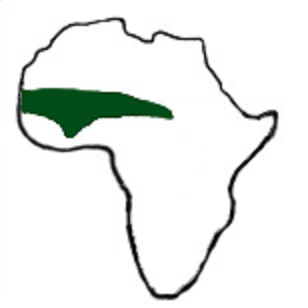
Lavender Waxbill - Estrilda caerulescens
Alternative names: Lavender Finch, Red-tailed Waxbill.
Length: 10cm, 4 inches.
Description: A small dove-grey finch with crimson lower back, rump and tail. Narrow black stripe from gape to and beyond eye. Lower flanks spotted with white. Bill black at tip and reddish at base. Legs black.Sexes are alike but can be sexed by call, the call of the cock is usually a two-note, two-syllable call, much louder than the hen’s single-note call.
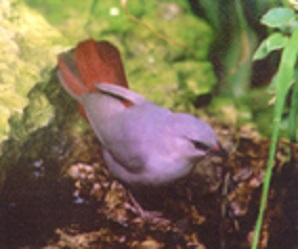
Distribution and Habitat: Tropical W.Africa, Senegal, Mali, N.Ghana, N.Nigeria, N.Cameroons.
Inhabits semi arid country with bushes and trees and some open areas of short grass. Feeds on the ground and in trees and bushes on seeds (including seeds of small fruit) and small insects. Roosts by preference in old nests.
Housing: In captivity can be sensitive to temperature changes and is best kept at a minimum of 10-15 degrees C. Can be kept in a group unless one pair decide to go to nest, when they may attack others of the same species possibly with serious consequences.
Breeding: Any two birds regardless of sex will carry out a greeting display by alternately bowing to each other.
Usually builds a rounded nest with downward sloping entrance tube. Will often build a cock’s nest on top of the real nest which will be decorated with feathers, droppings, dead nestlings etc. Both sexes incubate. Young fledge 16-18 days after hatching and are usually self-sufficient at about 20 days from fledging. A plentiful supply of live food will be required when feeding young. Will take small mealworms, buffalo worms, white worms, blood worms (mosquito larvae) wax-moth larvae, fruit-fly, small spiders etc.
Now available: WFS keeping and breeding booklet for this species.
-
-
77 - Black-headed Nun (Lonchura atricapilla - sometimes Lonchura malacca atricapilla)
-
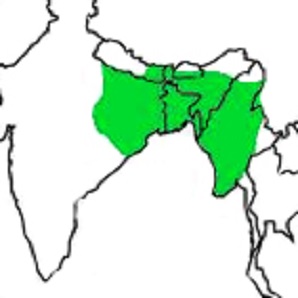
Black-headed Nun - Lonchura atricapilla - sometimes Lonchura malacca atricapilla
Alternative names: Black-headed Munia, Black-headed Mannikin, Chestnut Munia or Mannikin
Length: 4.25 to 4.5in (10.5 to 11.25cm).
Description: Head, upper breast, centre of belly and under tail coverts are black. The rest of the underparts are a chestnut reddish/brown. The lower breast and flanks are brown. Eyes are brown, beak is silver grey and the legs are dark blue/grey. Both sexes are very similar though the black upper breast on the males is slightly larger and also the beak is bulkier, though this cannot always be relied upon when sexing. Juveniles are much lighter in general than the adult. There are several subspecies of the Black-headed Nun, in some of which the black head and upper breast are a dark brown.
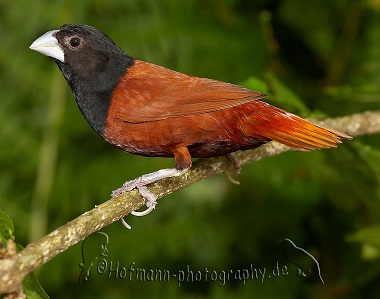
Distribution and Habitat: The Black-headed Nun is found in open grassland, reed beds, rice fields and marshes. Where this preferred habitat does not exist other cultivated land or clearings in forests will be utilised. They form large flocks throughout the year other than in the breeding season. At this time flocks are smaller due to adult birds going to nest.
Housing: The Black-headed Nun is quite a placid bird and mixes well in a communal aviary. However breeding success is more likely by keeping a single pair in an aviary/cage of its own. There is a danger of hybridisation if kept with other mannikin species.
Feeding: In the wild these mannikins feed almost entirely on seeding grasses direct from the seed head, though they will feed on the ground if circumstances dictate. Rice is a favourite when available. There appears to be no appetite for insects, even when feeding young.
Breeding: In its natural habitat, the nest is made of fresh green leaves and grasses. It is roughly a 6 inch oval with an entrance on the side. The nest is constructed in reeds, grasses, bamboo etc. The average clutch size is 3 to 5 and incubation is about 13 days. The young are brooded for a further 10 days. Youngsters fledge approximately 3 weeks after hatching and are raised primarily on grass seed.
Photograph by permission from http://www.hofmann-photography.de/html/welcome.html
Now available: WFS keeping and breeding booklet for this species.
-
-
75 - Black-cheeked Waxbill (Estrilda erythronotos)
-

Black-cheeked Waxbill - Estrilda erythronotos
Alternative names: Black-faced Waxbill
Length: 12-13cm, 4.5-5 inches.
Description: Head and throat grey, being darker on the crown, with black side patches. Bill is black at tip, fading to blue-gray at base. Back is brown, faintly barred. Wing coverts and secondaries striped black and white. Rump and tail coverts red, underparts grey with pink tinge becoming red on flanks and belly, with black vent. Female is paler, with brown vent. Juveniles resemble the female, with a darker bill. There are several geographical variants with subtle plumage differences.
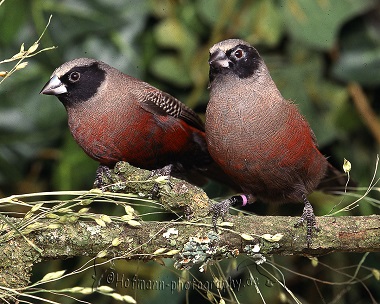
Distribution and Habitat: Frequents dry grassland with thornbush or acacia scrub, the edges of woodland and sometimes cultivated areas. Feeds on (or close to) the ground, mainly on grass seeds and millet. Will also take small insects, fruit and buds and the blossoms of fruit trees (possibly to obtain pollen or nectar).
Housing: Should be kept in a controlled environment as this species is particularly sensitive to cold and to temperature changes generally.
Feeding: A standard waxbill seed mixture, with additional wild/weed seeds as basic diet. Supplement with seeding grasses whenever possible. Black-cheeked Waxbills are thought to favour aphids, ant pupae and soft mealworms when feeding young and will also utilise sprouted seed.
Breeding: Builds a relatively large nest with an entrance tube, consisting mainly of grass stems. The nest will often have a ‘cock nest’ on top, this frequently has feathers added, whereas the main nest rarely does. A clutch may be 3-6 eggs and is incubated by both sexes for 12 days. Fledging takes place at 22 days.
References: Goodwin (1982); Clement, Harris and Davis (1999); Restall (1975).
Photograph by permission from http://www.hofmann-photography.de/html/welcome.html
For further general information see Care of Waxbills page.
-
-
72 - Dusky Mannikin (Lonchura fuscans)
-
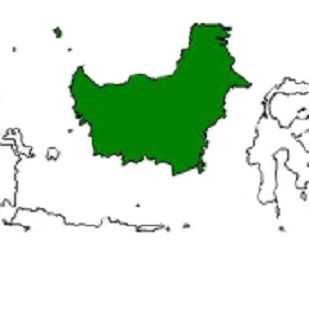
Dusky Mannikin - Lonchura fuscans
Alternative names: Dusky Munia.
Length: 4in (10cm).
Description: The Dusky Mannikin is similar to the Java Mannikin but without the white on the belly. They are completely brownish black with darker tips creating a scaled look. There are variations in colour of each individual some being more scaled than others. The upper beak is black and the lower beak is a bluish grey as are the legs.
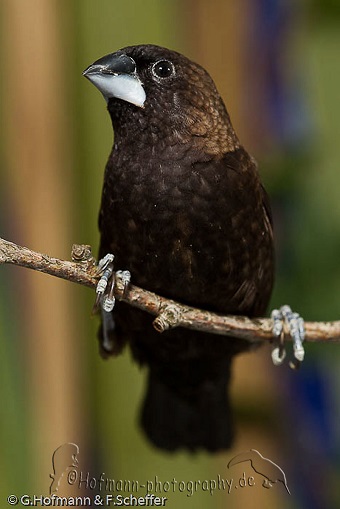
The sexes are very difficult to distinguish. Juveniles are dark drab to burnt umber above, slightly darker on the wings and tail. Below it is dark drab. The beak is black on fledging.
Distribution and Habitat: Dusky Mannikins are found mostly in lowland Borneo, occurring up to only 500m or so. Will be found in open grassland, cultivated land, paddy rice fields, reedbeds and riverbanks. They may be found in gardens and around human habitation.
Housing: The Dusky Mannikin is little different from other Munias within its range. It is somewhat a skulking bird described as mouse like. Keeping low in vegetation and feeding on the ground mostly. One of its characteristics is little fear of man.
Feeding: Feeds both on the ground and in vegetation, climbing up stems to reach seeding grasses. They eat all kinds of grass seeds and weed seed and they have a particular liking to growing rice.
Breeding: WFS records show that this species is progressively being bred each year. In its natural habitat, the nest is usually found in holes in banks, among exposed roots and in holes in trees. The Dusky Mannikin accepts various nesting receptacles in captivity from wicker baskets to half-open nest boxes. Average clutch size is 3 to 6 and incubation is about 13 days. Youngsters fledge in approximately 3 weeks.
References: Restall (1996)
Photograph by permission from http://www.hofmann-photography.de/html/welcome.html
Now available: WFS keeping and breeding booklet for this species.
-
-
72 - Magpie Mannikin (Lonchura Fringilloides)
-
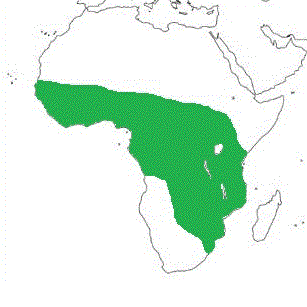
Magpie Mannikin - Lonchura Fringilloides
Alternative names: Pied Mannikin
Length: 11.5cm (4.5 inches).
Description: Head is glossy black, Back is dark brown as are the wings. Tail is black with white below with black and brown barring on the flanks. Bill is heavy long and pointed. As with many mannikins the sexes are difficult to tell apart. Juveniles are similar to Bronze-winged mannikins and black & white mannikins but are distinguishable by their size.
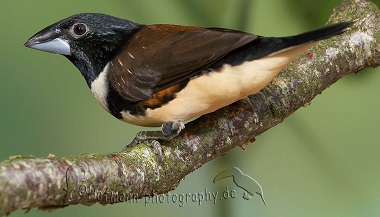
Distribution and Habitat: There are 2 subspecies of the Magpie Mannikin spreading across from the West to East coast of Africa from Senegal and Gambia to Kenya, Tanzania and Natal. It is a bird seldom found far from water preferring to roost in reed beds preferring to habit near thickets of bamboo.
Housing: The Magpie Mannikin quite a shy bird that will flee to dense cover if disturbed. More often found in pairs or small family groups not often seen in flocks of more than 10 unless found in where bamboo is seeding.
Feeding: In the wild these mannikins feeds on seeding Bindura bamboo, seeding grasses and termites. In captivity they take eggfood, soaked, sprouting seed and mini mealworms.
Breeding: WFS records suggest that this species was bred each year between 2002-2010 peaking in 2009.
In its natural habitat nests are built in bamboo thickets, bush or trees. The nest is generally round with a side entrance built using grasses and leaves and lined with bamboo flowers and feathers. The average clutch size is 4 – 6 eggs, incubation is about 15 days. Youngsters fledge approximately 21-26 days later.
Photograph by permission from http://www.hofmann-photography.de/html/welcome.html
For further general information see Care of Waxbills page.
-
Available profiles of species outside the top 30 most-bred by WFS members in the last five years (2019-2023)
-
68 - Red-eared Waxbill (Estrilda troglodytes)
-
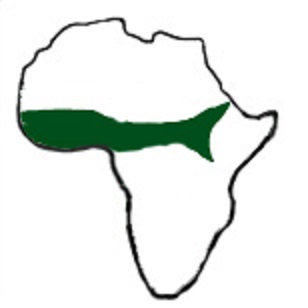
Red-eared Waxbill - Estrilda troglodytes
Alternative names: Black-rumped Waxbill, Grey Waxbill, Pink-cheeked Waxbill, Common Waxbill (this name is also used for the St Helena Waxbill)
Length: 10cm, 4 inches.
Description: Male and female are similar in appearance. Upper parts light brownish grey with cross barring. Deep scarlet eye stripe running narrowly under, as well as more widely above the eye. Throat and ear coverts silky white, usually tinged with pink or grey. Underparts as upper but much paler.
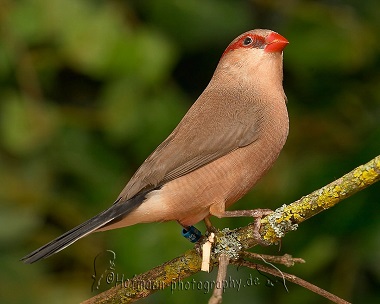
Ventral area rosy red. Undertail coverts white, usually tinged with pink. Rump, upper tail coverts and tail black. There is a great deal of variation in the amount of red on the underparts. Bill bright red to crimson.
Distribution and Habitat: From Senegal and The Gambia east to NE Congo, Uganda, Eritrea and NW Abyssinia.
Housing: Generally not aggressive. When kept in an aviary a heated shelter is essential.
Feeding: Feeds both on the ground and from growing vegetation. Takes grass and other seeds together with midges and small insects.
In captivity will eat panicum, white millet, small canary seed and other small seeds. Seeding grasses, soaked seed, small insects or ant pupae should be provided when they are nesting.
Breeding: Nests are often built on the ground in grass or under a small bush, often with a cup-shaped cock’s nest at the side, but will nest above ground in a bush or basket. Nest is built of grass, coconut fibre or similar material and is usually lined with feathers or other soft material. Usually four or five eggs, which are incubated by both sexes. Incubation period is 11 to 12 days.
Photograph by permission from http://www.hofmann-photography.de/html/welcome.html
Now available: WFS keeping and breeding booklet for this species.
-
-
56 - Tri-coloured Nun (Lonchura malacca - sometimes Lonchura malacca malacca)
-
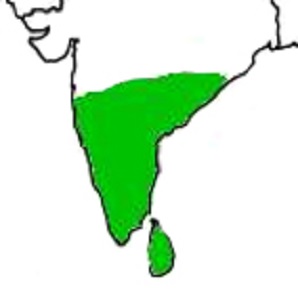
Tri-coloured Nun - Lonchura malacca (sometimes Lonchura malacca malacca)
Alternative names: Tri-coloured Mannikin, Tri-coloured Munia
Length: 11-12.5cm (4.5-5 inches)
Description: Sexes alike. Head, breast, throat, centre of and tail black. Nape, belly,tibial feathers and under tail coverts black. Rest of under parts white. Mantle, back and most of wings light chestnut. Underwing coverts white to reddish buff. Rump and upper tail coverts glossy dark chestnut, spotted bars of black. Bill palish grey and legs leaden blue or slate
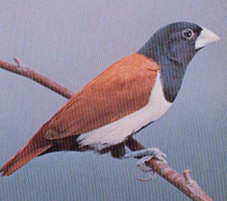
Distribution and Habitat: Southern India. In the wild inhabits marshes, reed beds, wet grassy areas, sugar cane and rice fields. Probably feeds largely on grass seeds. Usually in small or large groups, but when breeding in pairs or small groups.
Housing: The Tri-coloured Munia is generally considered not to be aggressive toward other species if kept in a mixed aviary. However there is little doubt that best breeding success will be achieved by keeping a small flock in an aviary of its own. There is a danger of hybridisation if kept with other Mannikin species.
Feeding: Will take millets and canary seed both dry and soaked and green food, especially seeding and flowering grasses and chickweed, millet sprays.Usually refuses insects and soft food. The usual grit and cuttlefish bone should be provided. When feeding young may take large quantities of soaked seed.
Breeding: WFS records suggest that this bird has been infrequently bred in captivity. In its natural habitat, the nest is a roughly oval construction of leaves and grasses measuring 6 or 7 inches in diameter, often with a tubular entrance porch. The nest is constructed in reeds, grasses, bamboos etc, usually within 2 metres of the ground. Average clutch size is 4 or 5 and both sexes share the incubation of about 13 days. Youngsters fledge between 22 and 28 days old.
For further general information see Care of Waxbills page.
-
-
50 - Indian Silverbill (Lonchura Malabarica)
-
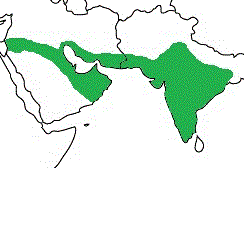
Indian Silverbill - Lonchura Malabarica
Alternative names: White-rumped Silverbill
Length: 11.5cm (4.5 inches).
Description: Male: The adult Indian Silverbill has a conical silver-grey bill, buff-brown upperparts, white breast and rump, buff/barring of flanks and dark wings. The tail is black and the wings are dark contrasting with a white rump.
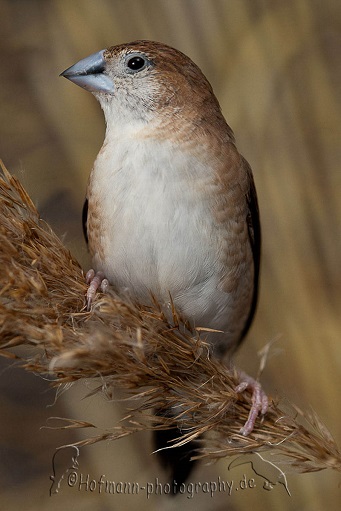
Female: The sexes are similar, the hens flanks do have less barring. The differences are clear to see when a pair of birds are together rather than sexing single birds.
Juveniles: Generally paler than the adults.
Distribution and Habitat: Range from the Eastern Province of Saudi Arabia, United Arab Emirates, Pakistan and Nepal through India to east Bengal and South to Sri Lanka.
Housing: The Indian Silverbill is not aggressive toward other species if kept in a mixed aviary. Breeding success can be achieved when kept a small flock in an outside aviary. There may also be a danger of hybridisation if kept with other Mannikin species.
Feeding: In the wild these Lonchura usually feed on the ground on fallen seeds and also on seeding grasses and millets. These birds will take live food but don’t require live food to raise their young. In captivity they take egg food and soaked or sprouting seed.
Breeding: WFS records suggest that this bird has been bred reasonably consistent in captivity.
In its natural habitat, the nest is more round than oval, constructed of straw and blades of grass. Nest baskets and boxes of various sizes should be hung at different heights to encourage breeding.
Average clutch size is 3 to 8 and incubation is about 13 days. Chicks skin colour is black , chicks tend to stay quiet until parents stop brooding the nest. Youngsters fledge approximately 19 days later.
Photograph by permission from http://www.hofmann-photography.de/html/welcome.html
For further general information see Care of Waxbills page.
-
-
50 - Melba Finch (Pytilia melba)
-

Melba Finch - Pytilia melba
Alternative names: Green-winged Pytilia
Length: 12cm, 5 inches.
Description: On the adult male, forehead, chin and throat are red, with the rest of the head and the neck being grey. The bill is bright red and the eyes orange or reddish-brown. The back is green or olive, which carries down to the upper rump, the lower rump and upper tail coverts are red and this colour extends into the tail feathers. The wing coverts and outer webs of the flight feathers are green, the inner webs being brown. Breast is yellowish or golden with a green tint, and has spotting showing through lower down. The belly and flanks are darker green and heavily barred with white; the centre of the belly often showing more white and less green.
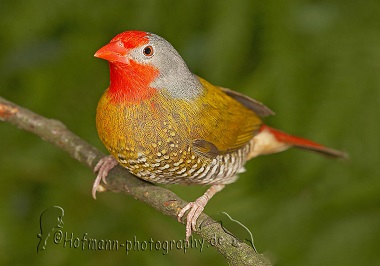
Females lack any red on the head, which is therefore all grey, the throat is off-white to pale grey, belly and flanks are darker grey with pale barring. This barring is less distinct than on the male. The female’s bill is dark brown, with pink to base of lower mandible. Juveniles are similar to adult female but colours are duller, including the bill. Young males will show red to the head in the first moult. There are several geographical variants which differ mainly in the amount of red on the head, different intensities of yellow hue on the breast, and in the brightness of the barring on the underparts.
Distribution and Habitat: Inhabits the drier areas of Africa, favouring thorn scrub, open woodland, savannah and the edges of cultivated areas. Feeds mainly on grass and millet seeds, but takes some insects - mainly termites.
Housing: The cock Melba Finch is usually aggressive to other males, particularly of any species showing red to the head, it is therefore advisable to keep breeding pairs in distinct compartments. Experienced keepers suggest that this is a bird requiring more heat than most, which would indicate indoor quarters being advisable for most of the year.
Feeding: In the wild this species is said to feed mainly on seeds and termites. Immelman et al (1963) suggest that birds in aviculture will thrive only if fed a wide variety of insect food throughout the year to supplement the usual foreign finch seed mixtures.
Breeding: The Melba Finch would seem to be very difficult to breed in captivity. In the wild, a dome-shaped nest of grasses and other vegetation is built close to the ground and lined with feathers. A clutch may be up to 6 eggs and incubation is 13 days, fledging takes place at 21 days. Paradise Whydahs will parasitise the nest of this species and might therefore be an interesting aviary companion, though a close watch must be kept for signs of aggression.
References: Clement, Harris and Davis (1999); Goodwin (1982); Restall (1975).
Photograph by permission from http://www.hofmann-photography.de/html/welcome.html
For further general information see Care of Waxbills page.
-
-
46 - Blue-billed Firefinch (Lagonosticta rubricata)
-
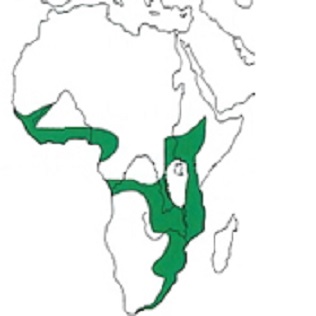
Blue-billed Firefinch - Lagonosticta rubricata
Alternative names: Dark Firefinch, African Firefinch (sometimes also used for other species).
Length: 4.5in (10-11.5cm).
Description: Dark grey crown and nape. Mantle, back and wing coverts olive brown. Rump and upper tail coverts wine red. Centre of belly sooty grey. Bill upper mandible dark grey or black, lower mandible black at tip and pink at base. Female: Upper parts a paler shade of brown, the top of the head may be brown or more grey than that of the male. Rump, tail, breast and flanks paler than the male. Breast buff and ventral area blackish brown.
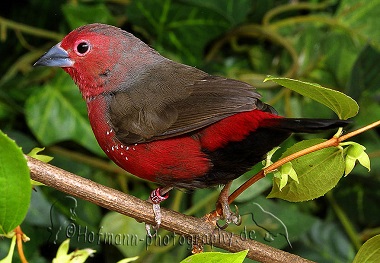
Differs from Bar-breasted (Lagonosticta rufopicta) by lack of white barring on the sides of the breast and mainly dark (not red) bill.
Differs from Black-bellied (Lagonosticta rara) by brown or grey brown mantle and back (not red). Black-bellied female has a grey head and face and both sexes have a much greater extent of black on the underparts.
Distribution and Habitat: Western, eastern, central and southern Africa.
Inhabits edges of forest and savanna woodland, thick cover along streams, densely grown valleys in hill country. Apparently needs a combination of fairly low cover and grass, Not found in open grassland.
Feeding: Feeds largely on grass seeds. Also takes termites and other small insects.
In captivity some breeders consider that live or egg food is necessary at all times but Goodwin reports that his birds showed little interest unless they were rearing young. He also reports that his birds, although timid at first, soon became tame and were very inquisitive and found their way round quickly.
Breeding: Nest in bushes or shrubs and sometimes at ground level, usually lined with feathers. Incubation period about 11 days. Fledge at approximately 15 days old. Birds will perform a greeting display by bowing alternately with twitching tails. In the courtship display the male will bob up and down with a feather or piece of grass in the beak, throwing his head back.
Photograph by permission from http://www.hofmann-photography.de/html/welcome.html
For further general information see Care of Waxbills page.
-
-
44 - Javanese Mannikin (Lonchura leucogasroides)
-
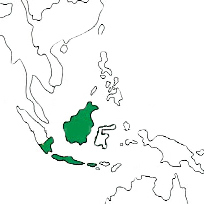
Javanese Mannikin - Lonchura leucogasroides
Alternative names: Javan Mannikin, Javan Munia, Black-rumped Munia
Length: 4 to 4.5in (10 to 11.5cm).
Description: Sexes alike. Generally dull or drab brownish wih a distinctive black foreface, chin, throat and breast. White lower breast and dark brown or blackish undertail coverts and tail. Bill blackish or dark horn grey upper mandible and pale greyish blue lower mandible. Legs and feet grey or bluish grey. Very similar to the White-bellied Munia (Lonchura leucogastra).
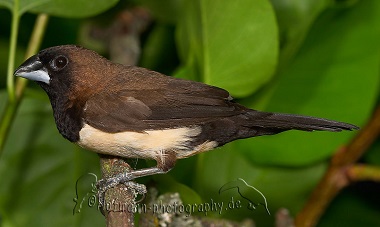
Distribution and Habitat: Southern Sumatra, Java, Bali and Lombok. Introduced into Singapore. In the wild inhabits cultivated areas rice fields, gardens and bushy and grassy areas. Eats grass seeds and cultivated rice, both ripe and unripe. Usually found in pairs or small parties.
Housing: In captivity this species seems well suited to cage life being relatively tame. Temperature should be maintained at above 10 degrees C.
Feeding: A Foreign Finch mixture, panicum and Japanese Millet and millet sprays. Most egg food and some insects may be taken. Cuttlefish bone, charcoal and a mixture of grits grits should be available.
Breeding: These birds have been bred in cages measuring 2ft x 18in x 18in with nest boxes (5in x 6in x 6in) attached to the outside of the cage. May use baskets and boxes. Usually 5 or 6 eggs are laid. Incubation period usually about 12 days and young fledge at 18-21 days old.
Photograph by permission from http://www.hofmann-photography.de/html/welcome.html
Now available: WFS keeping and breeding booklet for this species.
-
-
27 - Red-winged Pytilia (Pytilia phoenicoptera)
-

Red-winged Pytilia - Pytilia phoenicoptera
Alternative names: Aurora Finch, Crimson-winged Pytilia
Length: 12cm (5 inches)
Description: Head and back are grey. Underparts are paler grey with fine white barring. Upper tail coverts crimson, tail is crimson with some brown streaks. Wings are grey-brown with the visible parts of most coverts and the outer edges of the flight feathers being crimson, showing as a large crimson patch on the side of the resting bird. Eyes are red and the bill is black, thin and finely pointed.
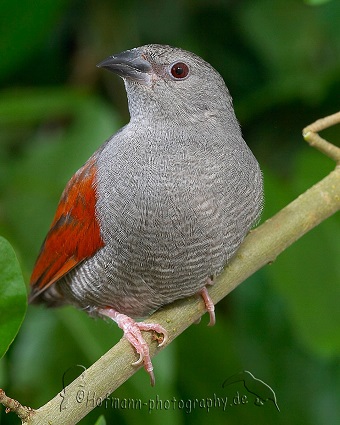
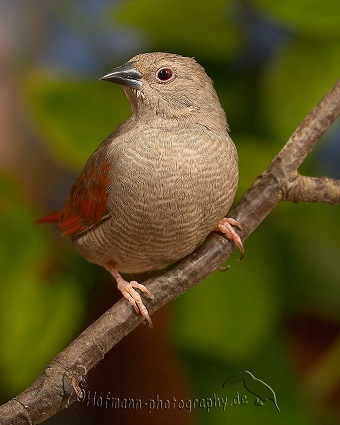
The female tends to be a paler version of the male, often with less extensive red markings. Juveniles resemble the female but with a more brown appearance and the eye is brown.
Distribution and Habitat: Favours open woodland and savannah, dense grassland or bamboo thickets and is said to be more often seen in trees than most waxbills. Usually seen singly or in pairs.
Housing: An inoffensive bird not known to be aggressive to other species or its own kind and usually very steady. Has been known to do well in a planted flight with heated shelter, but it is thought that best breeding results will be obtained by maintaining a temperature around 20 degrees.
Feeding: In the wild the Red-winged Pytilia feeds mostly on the ground, taking mostly grass seeds and some small insects such as ants and termites. In captivity a good foreign finch mixture supplemented with soft food is a basic requirement and the addition of seeding grasses in season will be appreciated. Successful breeding has been achieved by supplying ant pupae and mealworms at the appropriate time.
Breeding: The nest is usually loosely constructed in a bush or small tree and will be sparsley lined with feathers . 3 to 4 eggs are laid and incubation is 12 to 13 days and carried out by both sexes, fledging takes place at around 21 days. Breeders have experimented with supplying artificial vegetation nesting sites, apparently with some success.
References: Clement, Harris and Davis (1999); Goodwin (1982); Restall (1975).
Photographs by permission from http://www.hofmann-photography.de/html/welcome.html
Now available: WFS keeping and breeding booklet for this species.
-
-
15 - Black-bellied Firefinch (Lagonosticta rara)
-
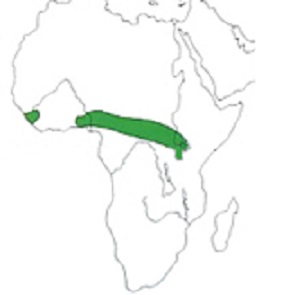
Black-bellied Firefinch - Lagonosticta rara
Alternative names: None highlighted
Length: 5.5-6in (13-14cm).
Description: Male : Head, face, neck, chin and throat to upper flanks deep scarlet. Mantle, back and wings black. Underparts jet black. Bill large and blue black.
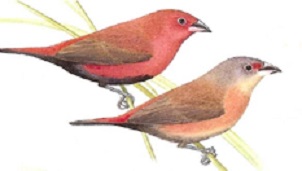
Female : Head to nape bright red. Mantle and wings olive brown. Underparts olive brown. Bill as male.
Distribution and Habitat: Cameroons to S.Sudan, N. Uganda and Kenya, Zaire, E. Sierra Leone and S.E. Senegal.
Inhabits savanna, grassland and cultivated areas.
Feeding: Feeds mainly on the ground on small seeds but will take termites and other small insects. In captivity will take panicum and spray millet and other small grass seeds. Insect food seems essential for rearing young. Egg food will sometimes be taken. Some breeders consider that insect or egg food should be supplied at all times.
Breeding: Prefers to roost low down and nesting is usually low down in a clump of grass or a bush or in the thatch roof of a hut.
The male will display to the female on the ground by hopping up and down with a piece of grass in the bill with head held obliquely upward.
For further general information see Care of Waxbills page.
-
-
15 - Five-coloured Mannikin (Lonchura quinticolor)
-
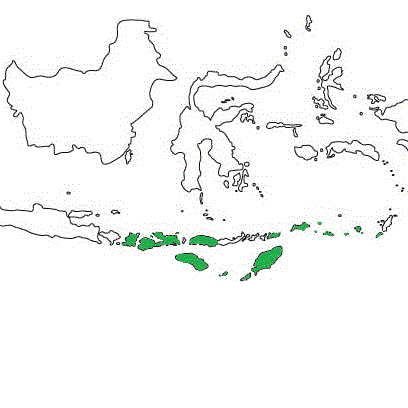
Five-coloured Mannikin - Lonchura quinticolor
Alternative names: Five-coloured Munia
Length: 12.5cm (4.9 inches).
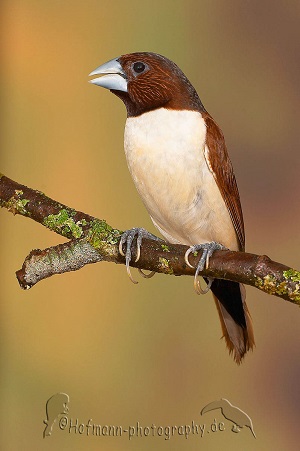
Description: Male and females identical other than the male has a broader beak compared to the female.
The head is dark brown with mid brown marking on the ear coverts. Under parts are various shades of brown, rump and upper tail are yellow-orange or maroon in colour. Breast, belly and flanks are white. Under tail coverts are black. Juveniles are very similar to Spice Finch and Pallid Munias which are all found in the same area of habitat.
Distribution and Habitat: There are 3 recognised subspecies of the Five-coloured Mannikin Finch which are found on some of the Indonesian islands like Timor, Sumba, Flores and Sermata to name a few. They are found in grasslands, paddy fields, scrub even in cultivated land where cereals grow.
Housing: The Five-coloured Munia is a sociable bird but does not flock in the numbers like the Spice Finch does. As with most Munia also a danger of hybridisation if kept with other Munia species.
Feeding: In the wild these mannikins feed on seeding grasses direct from the seed head and is a very agile Munia climbing from stem to stem as the cross. They also have a great liking of rice. In captivity they will take eggfood, livefood, soaked and sprouting seed.
Breeding: WFS records suggest that this bird has not been bred consistently in captivity.
Their natural nest is spherical, constructed of blades of grass. Average clutch size is 4 to 6 and incubation is approximately 14 days. Youngsters fledge approximately 21 days later.
Photograph by permission from http://www.hofmann-photography.de/html/welcome.html
For further general information see Care of Waxbills page.
-
-
15 - Orange-winged Pytilia (Pytilia afra)
-
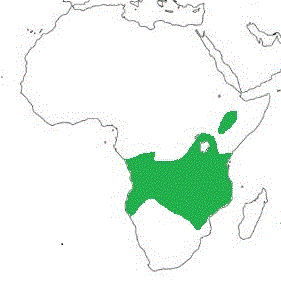
Orange-winged Pytilia - Pytilia afra
Alternative names: Red-faced Finch, Yellow-backed Pytilia, Golden-backed Pytilia
Length: 11.0 cm (4¼-4½ inches).
Description: Male: Forehead, face to rear or ear coverts, cheeks and chin are blood red to crimson. Crown and nape is grey. Mantle and back yellowish green. Rump and uppertail coverts are crimson. Tail is red inner webs are brown. Edgeing of wings are orange. Throat to side of neck and upper breast are pale grey. Breast is olive green can also have an orange/yellow tinge to it which becomes barred on the belly, flanks and undertail coverts. Bill is red, short and pointed. Eyes orange or red. Legs and feet are pale pink to flesh colour.
Female: similar to male other than red around the head which is grey to slightly olive. Upper and lower breast to belly olive to white barred. Bill and legs as per male.
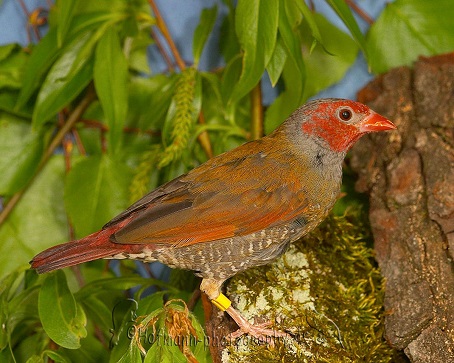
Juvenile: Very similar to the female but more dull to brown. Barring is less clear. Bill is dusky pink eyes are brown.
Distribution and Habitat: The Orange-winged Pytilia comes from south Sudan, and Ethiopia, south west to lower Congo, central Angola, Zaire to North west Kenya, Zanzibar, Tanzania, North Zambia, Botswana, Zimbabwe, Malawi, North Mozambique, North Transvaal and South Africa. Widespread inhabitants of scattered bush or dry open country. Found in thornscrub, forest edge open woodland. Generally prefer moist areas.
Housing: The Orange-winged Pytilia occur in small flocks or larger loose flocks. Often found with the Melba Finch (green-winged Pytilia).
Feeding: In the wild these Estrildids feed an all manner of grass seeds, small seeds and insects (termites, ants)
Breeding: WFS records shows that all the Pytila species popularity is going from strength to strength in recent years and also being bred in good numbers. The nest in the wild is usually built in a bush, and consists mainly of grasses. In captivity an open-fronted nest box seems to be the preferred platform. The average clutch size is 4 eggs and incubation is about 12-13 days. Youngsters fledge approximately 18 days after hatching and are raised primarily on insects, seeding grasses are also taken. The Orange-winged Pytilia is also breeding host to the Broad-tailed Whydah & Paradise Whydah.
Photograph by permission from http://www.hofmann-photography.de/html/welcome.html
For further general information see Care of Waxbills page.
-
-
13 - Quailfinch (African & Black-chinned) (Ortygospiza atricollis, a.ugandae, a.fuscocrissa, a.muelleri, a.smithersi & a.pallida / Ortygospiza gabonensis, g.fuscata & g.dorsostriata)
-
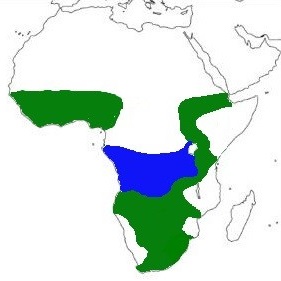
Quailfinch (African & Black-chinned)
Ortygospiza atricollis, a.ugandae, a.fuscocrissa, a.muelleri, a.smithersi & a.pallida
Ortygospiza gabonensis, g.fuscata & g.dorsostriataAlternative names:
Ortygospiza atricollis – African, White-chinned
Ortygospiza gabonensis – Black-chinned, Red-BilledLength: 9.5 - 10.5 cm (3.75 - 4 inches).
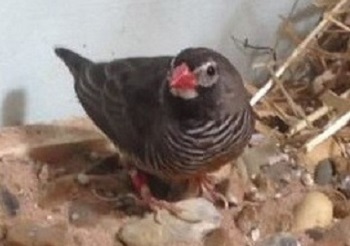
Description of nominate race: atricollis (shown in green on the mini map, blue is gabonensis species). Male: Blackish face with grey crown are ear coverts. White rings around eyes as well as a white chin, upper chest white and black barring. Tail dark grey warm brown breast to belly. Chocolate brown with greyish wash. Flanks black and white barring with a brown tinge. Bill short and red to dark brown. Legs and feet pinkish flesh colour or yellow/brown.
Female: Similar in most respects to the adult male but pale or greyer lacking in any strong plumage tones.
Juvenile: Similar to adult female but paler still. Bill is a darker colour with orange tinge to the base. Not that distinguishable between the atricollis and gabonensis.
Description of nominate race: gabonensis (shown in blue on the mini map, green shows atricollis species) Male: Forehead, lores, chin and throat black. Crown, nape and wing coverts slate grey/brown with buff brown edges give a mottled effect. Rump and tail streaked brown with white edge. Underparts are barred same as African Quailfinches (atricollis) but lower breast and belly faded to dull white. Bill bright red legs and feet dull brown/flesh colour.
Female: Very similar to male but head and coverts lighter slate grey. Generally dusky brown similar to the atricollis hen other than brown on the lower wing coverts. Beak Red as per male same as legs and feet being a dull brown /flesh colour.
Juvenile: Not that distinguishable between the atricollis and gabonensis.
Difference in species: Main difference between both atricollis and gabonensis is the atricollis have a distinct white chin and most subspecies have white eye rings whereas the gabonensis do not have these markings.
Distribution and Habitat: There are 7 subspecies of the African Quailfinch across 2 species. The atricollis range from Guinea to Nigeria, Ethiopia, Kenya, Tanzania, Zambia, Angola, Botswana & South Africa. Shown as Green on the mini-map. Gabonensis range from South Congo, Angola and Zambia regions. Shown as the blue territory on the mini-map. Chinned Quailfinch. Found in grass tussocks in sandy plains or swampy areas, also in open crops such as corn. Not usually seen until disturbed.
Housing: Due to their shy nature plenty of cover helps. Especially when kept in cages. If disturbed they tend to fly straight up so this needs to be thought of when housing them. A quitter part of the bird room is better suited. It is best to put a stone on the floor of their cages or aviary to help keep there claws in good condition.
Feeding: In the wild these finches feed almost entirely on grass seeds, with few small insects and spiders taken.
Breeding: Although recently this species has been bred fairly regular within the WFS it has not been bred in great quantities but as more attention is given to this species the future looks promising. Best results are coming from cage breeding this species. Clutch size is typically 4-6 eggs with 14 days incubation and the young fledging around 18 days after hatching.
Photograph by permission from Roy Jones.
For further general information see Care of Waxbills page.
-
-
11 - Green-backed Twinspot (Mandingoa nitidula)
-

Green-backed Twinspot - Mandingoa nitidula
Alternative names: Green Twinspot, Schlegel’s Twinspot
Length: 4-4.5in (10-11cm).
Description: Male is red or deep orange-red around the eye, with head and back a deep moss or olive green. Breast, belly and flanks dark grey to black, boldly spotted with white. Bill fairly short, slender and pointed, all black or with red at tip. Legs and feet pinkish brown. Female is similar to male but somewhat duller and lacks the bright red face. Face buff or fawn brown. Breast, belly and flanks rather greyer than the male and spots are less distinct. Juvenile is similar to the female but much duller and lacking the spots on the underparts. Young males show tinges of green on the breast and spots appear gradually in an erratic or random fashion.
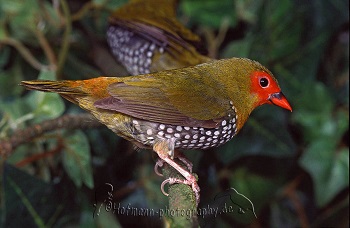
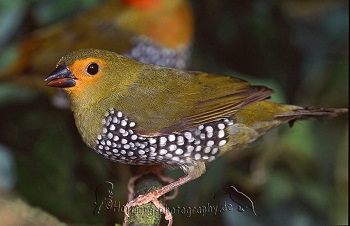
The above description is of the nominate race, M.nitidula nitidula. M.n. chubbi is brighter in colour. M.n.schlegeli has a larger bill. Face is deep scarlet and breast deep red to golden orange.
Distribution and Habitat:
M. nitidula nitidula - Tanzania, Zaire, Zambia, Malawi, Zimbabwe, Mozambique, Natal and N.E. Cape Province.
M. nitidula schlegeli - Sierra Leone, S. Guinea, Liberia, Ghana, Cameroon, Uganda, Tanzania, Zaire and Angola.
M. nitidula chubbi - Sudan, S. Ethiopia, Kenya, N. Tanzania and Zanzibar.
Inhabits dense riverine or secondary forest, edges of forest. Tall or rank grassland, evergreen thickets and other dense undergrowth. Occasionally in open ground but always near cover.
Feeding: Feeds on a variety of small seeds and insects but has been known to take rice. In captivity they need a plentiful supply of insect food as well as dry and soaked seed.
Breeding: Incubation period 12 – 13 days. Fledging at about 21 days. Both adults and young make a snapping sound when in the nest if they feel threatened.
Photograph by permission from http://www.hofmann-photography.de/html/welcome.html
For further general information see Care of Waxbills page.
-
-
4 - Black-crowned Waxbill (Estrilda nonnula)
-
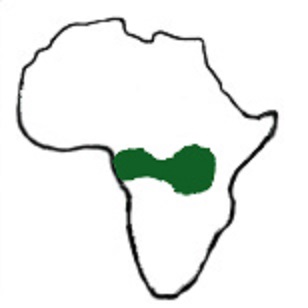
Black-crowned Waxbill - Estrilda nonnula
Alternative names: Black-capped Waxbill, White-breasted Waxbill
Length: 11-12cm, 4.5 inches.
Description: This and the Black-headed Waxbill are very similar. Much paler grey on upperparts than the Black-headed and has virtually all white (tinged grey) underparts whereas the Black-headed has black on the vent and a larger area of red on the flanks.
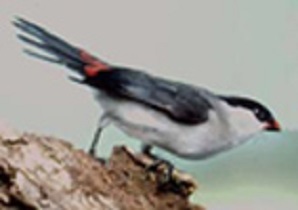
Male: Lores and forehead to crown and nape jet-black. Back and wing coverts ash grey finely barred dark grey or black. Rump and upper tail coverts deep crimson. Tail black and rounded at the tip. Face white extending to entire underparts except for greyish tinge on sides of breast, lower breast and flanks. Undertail coverts tinged grey. Small crimson patch on lower flanks. Bill patterned in light red and black on both mandibles.
Female: Similar to male but slightly greyer brown mantle with less distinct barring, and white parts are usually more suffused with grey particularly in vent area. Differences are more apparent when viewed in good sunlight.
Distribution and Habitat: S.E. Nigeria, Cameroons, S.W. Sudan, Uganda, S.W. Kenya, E. Congo, Zaire.
Inhabits forest clearings, forest edge, cultivated areas or savannah with abundance of bushes.Feeds largely on grass seeds including cultivated millet. Catches flying termites on the wing. Said also to feed on buds. Highly social, sometimes in very large flocks.
Housing: In captivity is reasonably hardy, but needs minimum temperature of 10 to 15 degrees C.
Feeding: Will feed on a mixture of small millets and canary seed and appreciates honey water/nectar. When feeding young requires small live food such as small, white mealworms, buffalo worms, white worms, bloodworms, fruit flies etc.
Breeding: In the wild, nests usually in a bush or tree from less than one to about six metres high. Several nests may be sited in the same tree. Nest built of grass stems usually with a shortish entrance tube sloping down and lined with feathers, vegetable down and fine fibres. Usually 4 to 6 eggs , incubation period is 11 to 13 days and young fledge at 20 to 22 days old. Both sexes share incubation by day. All calls are very soft and high pitched, the nest call being a faint soft twittering. Male may display holding a stem of grass and jerking the head upwards but female may display in similar manner, usually without the grass.
Will nest and breed in a colony or as a single pair (as it is difficult to sex accurately it is easier to use the colony system).
Suffers from a tendency to lose feathering on the head when over two years of age (probably a dietary deficiency). This does not, however, appear to affect breeding capacity.
Now available: WFS keeping and breeding booklet for this species.
-
-
4 - New Britain Mannikin (Lonchura spectabilis)
-
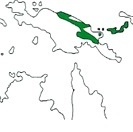
New Britain Mannikin - Lonchura spectabilis
Alternative names: None listed
Length: 3.75 to 4.25in (7.5 to 10.5cm).
Description: Male: Head, face, chin and throat black. Mantle,back and scapulars light chestnut or warm brown. Breast white. Upper tail coverts golden orange. Lower flanks black. Bill stout and deep pale grey. Legs and feet dark grey.
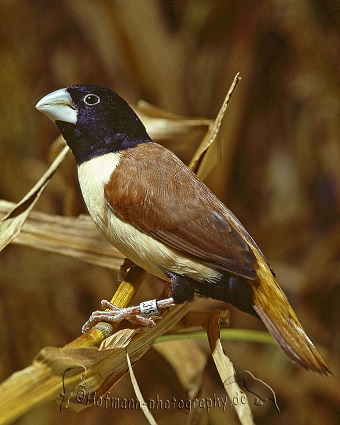
Females: similar to male but slightly less intense colouring.
Distribution and Habitat: New Britain and New Guinea.
Occurs in lowland grass lands and feeds mainly on small seeds. In the wild associates in flocks of up to 30 or 40 birds.
Housing: They have been bred in double breeding cages but were found to be aggressive if housed with other pairs.
Feeding: It has been reported that in captivity they will take millet, canary seed and spray millet and will feed young on spray millet, soaked seed and green seeds and at about seven days old will feed mini mealworms and buffalo worms.
Breeding: Nest is large, ball shaped and made of grasses with a tubular entrance. Will build nests for roosting but these have a larger entrance hole. Both sexes incubate by day but only the hen at night. Usually three to five eggs are laid. Incubation period is 14-15 days and fledge at 21 days. Young are usually independent 14 – 18 days after fledging.
The Census of reported Breedings of this species in the UK showed two being bred in 1998, two in 2005 and two in 2008 so it's shown a marked increase in numbers bred over the intervening years.
Photograph by permission from http://www.hofmann-photography.de/html/welcome.html
Now available: WFS keeping and breeding booklet for this species.
-
This site has been designed to run on all types of media so we would be extremely grateful if you could let us know if you experience any difficulties with how the page loads.
And finally, comments and feedback as well as additional entries on/ for these profiles are warmly welcomed and should be addressed to Darren Smith at:
With many thanks
